 Most of the current collections growth at the Western Science Center comes in the form of mitigation projects, fossils and artifacts that are recovered during various construction projects. Most of the projects that have come to us are from Riverside County, but we're increasingly starting to bring in material from other areas.Earlier this week we received several Colombian mammoth bones from a Caltrans road project in Merced County, California. The fossils were recovered and beautifully prepared by PaleoResource Consultants. While it appears that all the bones are mammoth, they do not appear to all come from one individual.One of the best-preserved elements is a lower jaw, shown above in dorsal view. The tooth in place is quite small, and is apparently either the fourth premolar or the first molar (I'm leaning toward the 4th premolar, but I need to examine it further to be sure). That makes this a very young animal; if the tooth is the 4th premolar it was probably only about 3 years old, and if it's the 1st molar it would still only be about 13 years old. There are going to be lots of things to work on in this small but significant collection.Thanks to Caltrans and PaleoResources Consultants for bring us this exciting specimen, and to Pat Holroyd at the UC Berkeley Museum of Paleontology, who put us in touch with PaleoResources.
Most of the current collections growth at the Western Science Center comes in the form of mitigation projects, fossils and artifacts that are recovered during various construction projects. Most of the projects that have come to us are from Riverside County, but we're increasingly starting to bring in material from other areas.Earlier this week we received several Colombian mammoth bones from a Caltrans road project in Merced County, California. The fossils were recovered and beautifully prepared by PaleoResource Consultants. While it appears that all the bones are mammoth, they do not appear to all come from one individual.One of the best-preserved elements is a lower jaw, shown above in dorsal view. The tooth in place is quite small, and is apparently either the fourth premolar or the first molar (I'm leaning toward the 4th premolar, but I need to examine it further to be sure). That makes this a very young animal; if the tooth is the 4th premolar it was probably only about 3 years old, and if it's the 1st molar it would still only be about 13 years old. There are going to be lots of things to work on in this small but significant collection.Thanks to Caltrans and PaleoResources Consultants for bring us this exciting specimen, and to Pat Holroyd at the UC Berkeley Museum of Paleontology, who put us in touch with PaleoResources.
Fossil Friday - Paramylodon claw
 Sloths are fascinating animals, with all kinds of strange anatomical features. One of their signature characters is their enormous claws. Although bones from the ground sloth Paramylodon are relatively common at Diamond Valley Lake, only a few claws were recovered. Technically, what usually preserves is the last finger bone, technically called the terminal phalanx or ungal. This is shown above from the side, and below from above:
Sloths are fascinating animals, with all kinds of strange anatomical features. One of their signature characters is their enormous claws. Although bones from the ground sloth Paramylodon are relatively common at Diamond Valley Lake, only a few claws were recovered. Technically, what usually preserves is the last finger bone, technically called the terminal phalanx or ungal. This is shown above from the side, and below from above: While we sometimes refer to ungals informally as "claws", it's important to recognize that the ungal is actually the bone that supports the claw. The claw itself is a keratin sheath that fits over the ungal. Keratin is rarely preserved, but there are a few mummified sloths (I don't think Paramylodon is one of them) in which the keratin claw is preserved; it is generally much longer than the ungal.Sloth ungals are always crowd pleasers at outreach events, so we recently molded this specimen and have started producing casts. Now that the molds are completed, the original claw will go back on permanent exhibit in the museum.
While we sometimes refer to ungals informally as "claws", it's important to recognize that the ungal is actually the bone that supports the claw. The claw itself is a keratin sheath that fits over the ungal. Keratin is rarely preserved, but there are a few mummified sloths (I don't think Paramylodon is one of them) in which the keratin claw is preserved; it is generally much longer than the ungal.Sloth ungals are always crowd pleasers at outreach events, so we recently molded this specimen and have started producing casts. Now that the molds are completed, the original claw will go back on permanent exhibit in the museum.
Fossil Friday - proboscidean ulna
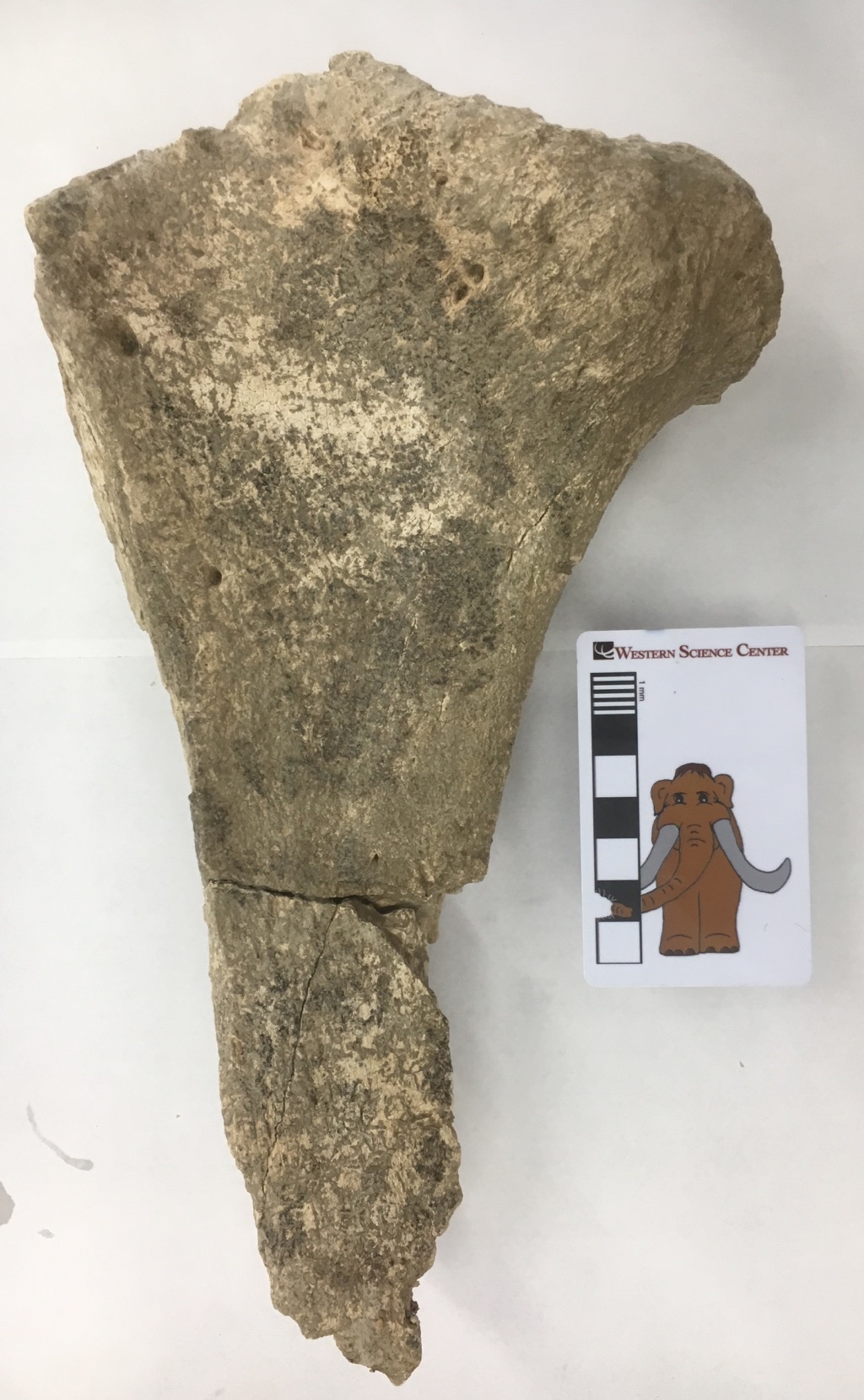 Over the last few weeks we've started pulling a lot of mastodon material from the collections (more on that in a future post). Some of the bones that are turning up are pretty interesting.The large bone fragment shown above is a small part of the proximal end of the right ulna, one of the bones in the forearm. It's shown above in lateral view, and below is looking at the proximal end (part of the articular surface for the elbow):
Over the last few weeks we've started pulling a lot of mastodon material from the collections (more on that in a future post). Some of the bones that are turning up are pretty interesting.The large bone fragment shown above is a small part of the proximal end of the right ulna, one of the bones in the forearm. It's shown above in lateral view, and below is looking at the proximal end (part of the articular surface for the elbow):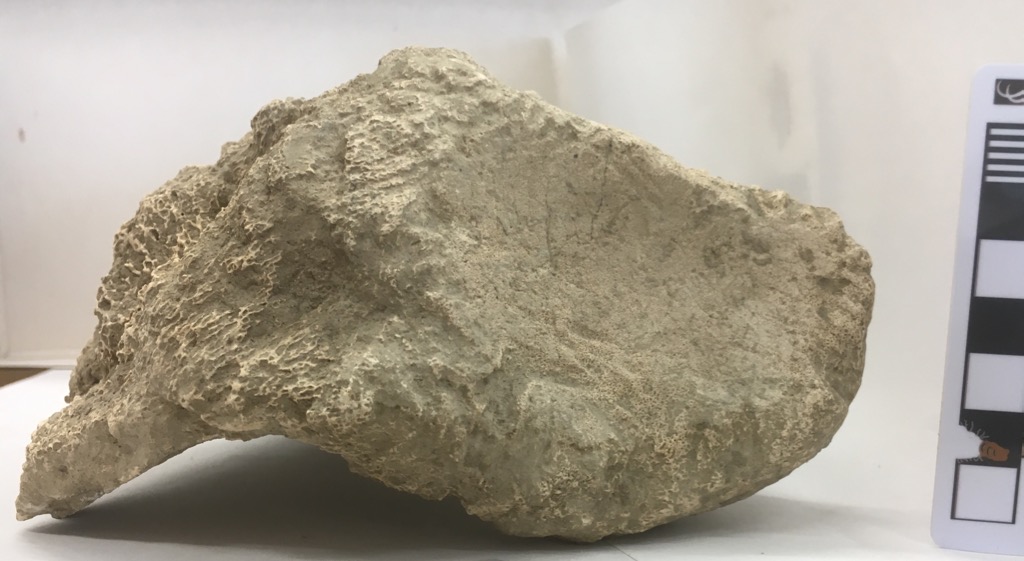 This fragment is labeled at mastodon, but comparing it to the photos in Olsen (1972) it seems to be closer to a mammoth (below). We'll have to examine it more closely and see if there's any associated material to determine for sure which taxon it belongs to
This fragment is labeled at mastodon, but comparing it to the photos in Olsen (1972) it seems to be closer to a mammoth (below). We'll have to examine it more closely and see if there's any associated material to determine for sure which taxon it belongs to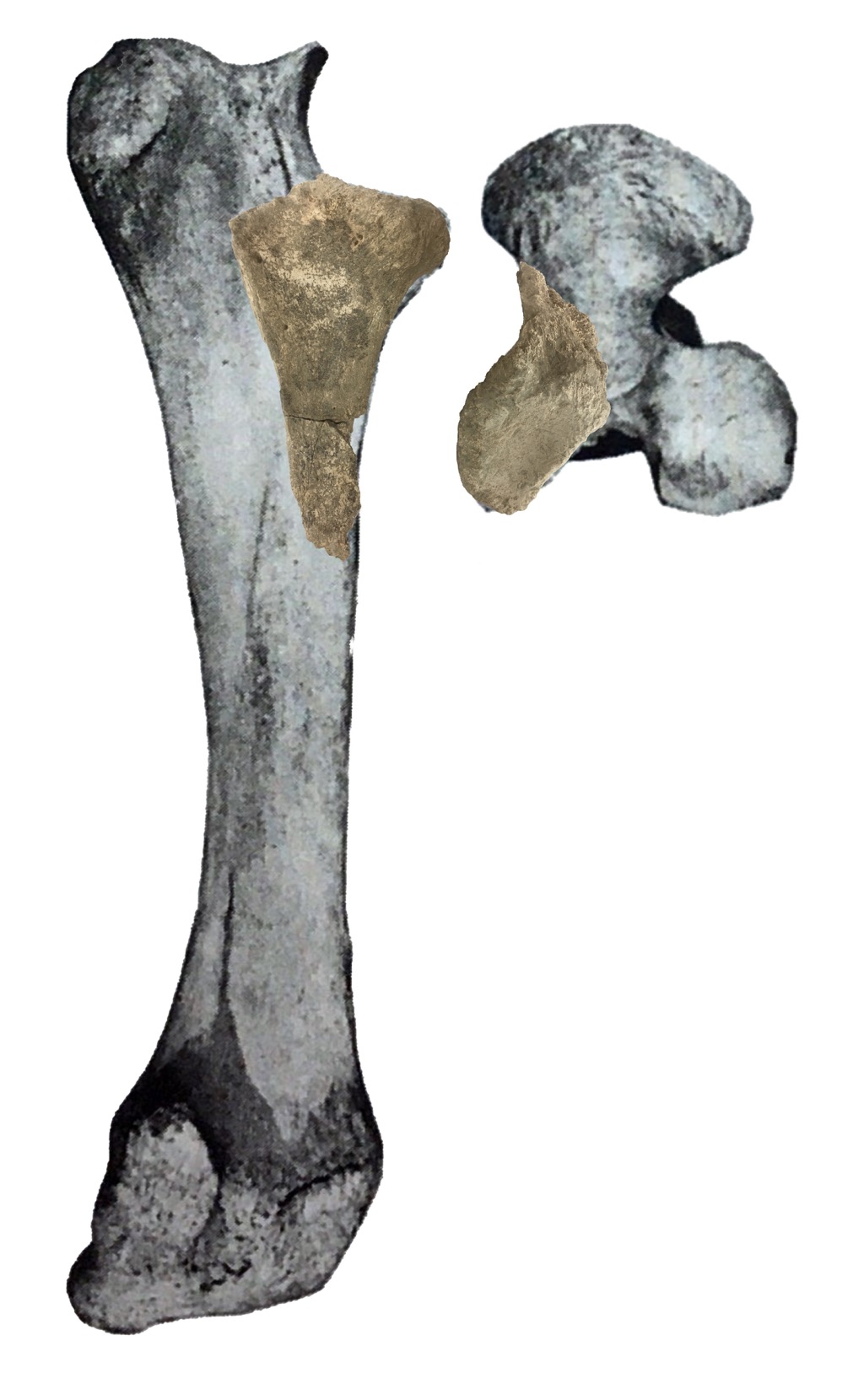 What really caught my attention were details on the edges of the articular surface and a few other places on the bone:
What really caught my attention were details on the edges of the articular surface and a few other places on the bone: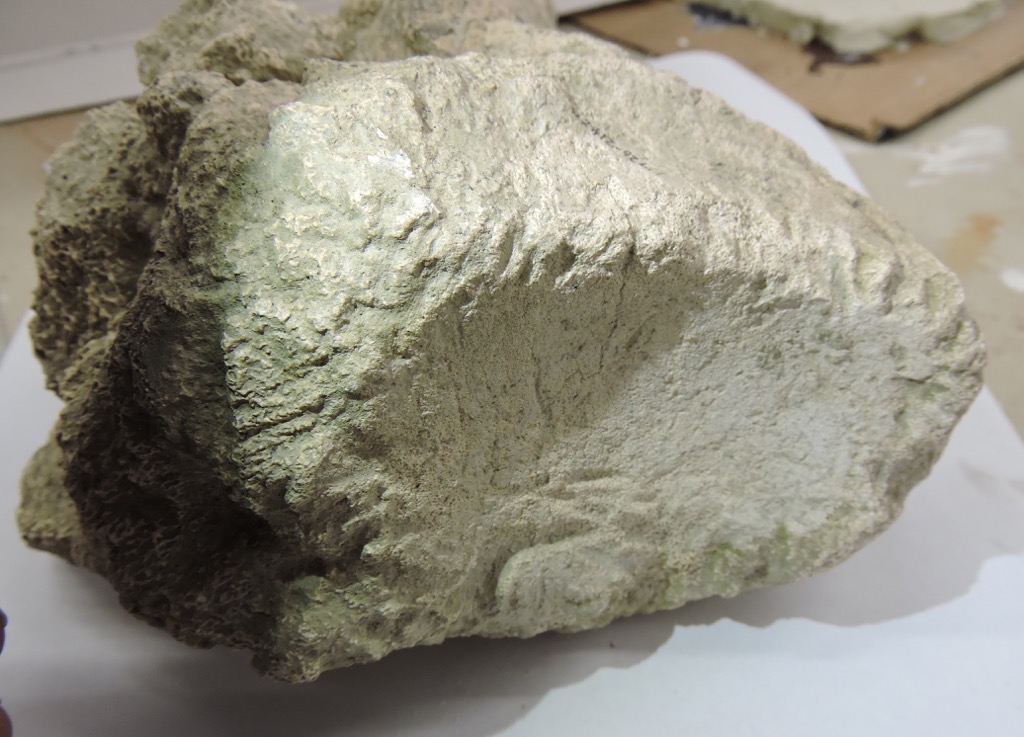
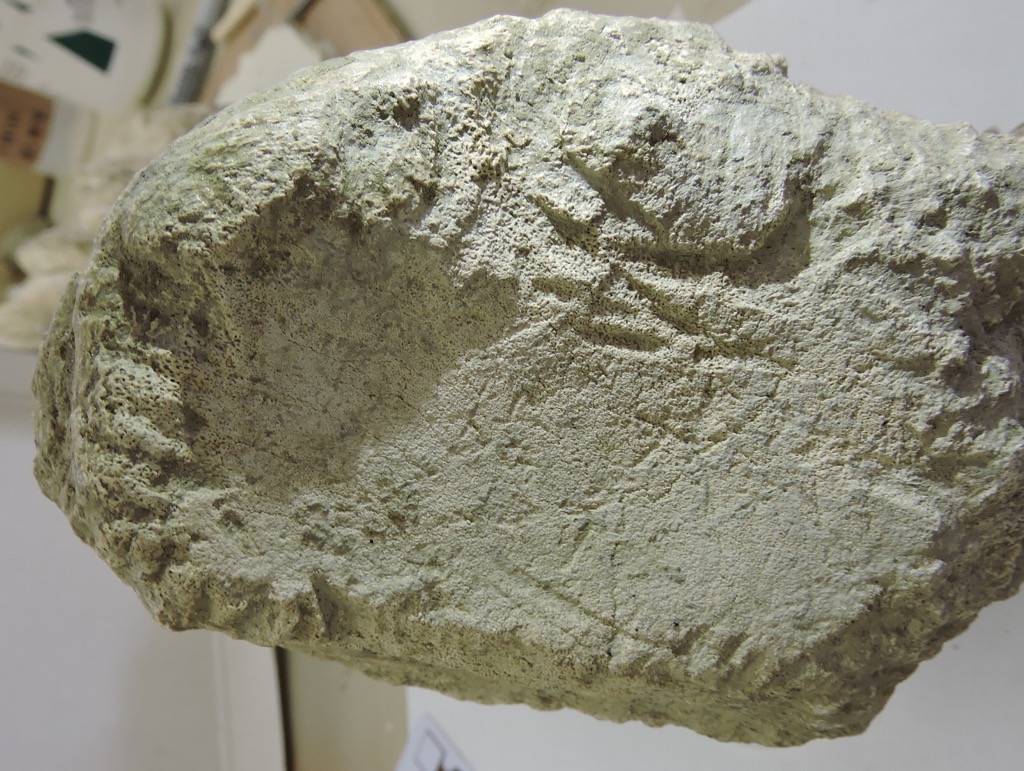
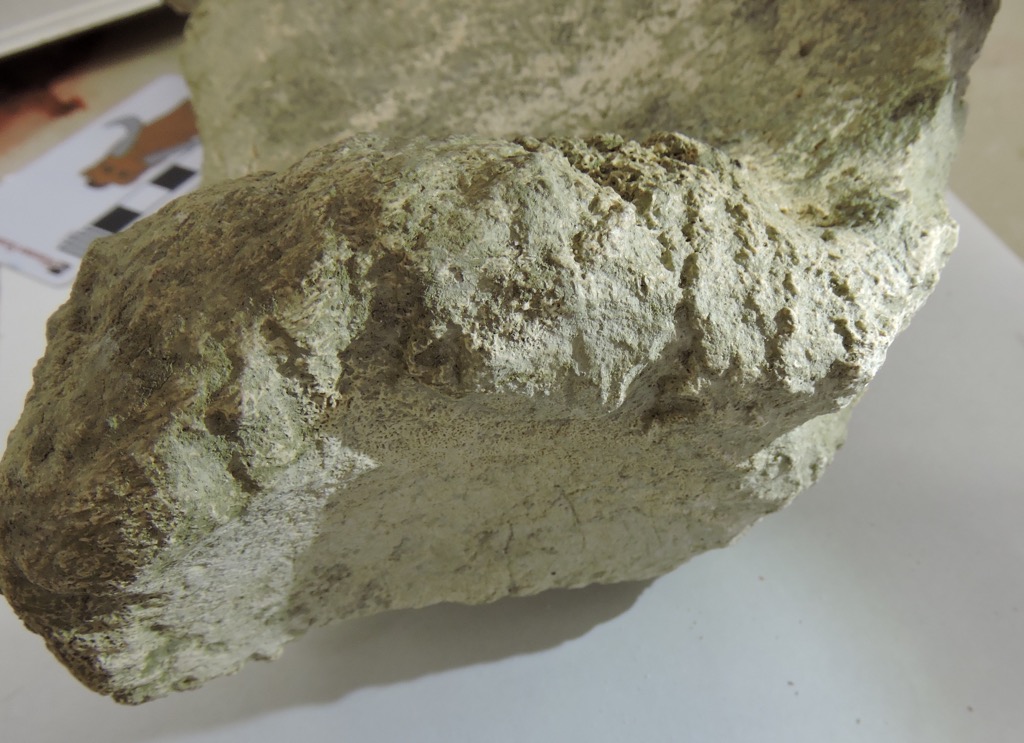 As we're finding with many of the large bones from Diamond Valley Lake, this bone is covered with bite marks from scavengers, in the form of notches cut into the edges of the bone. These are relatively large grooves, consistent in size with something like a coyote or dire wolf, but there are lots of possibilities.
As we're finding with many of the large bones from Diamond Valley Lake, this bone is covered with bite marks from scavengers, in the form of notches cut into the edges of the bone. These are relatively large grooves, consistent in size with something like a coyote or dire wolf, but there are lots of possibilities.
Reference:Olsen, S. J., 1972. Osteology for the Archaeologist No 3: The American mastodon and Wooly mammoth. Papers of the Peabody Museum of Archaeology and Ethnology, Harvard University 58:1-43.
Fossil Friday - pea clam
 While the Diamond Valley Lake fossil fauna is best known for its mammals, there were also thousands of mollusks recovered. These are mostly minute freshwater species, and even though we have thousands of them the all fit easily in a single specimen case.While most of these mollusks are gastropods (snails), there are some bivalves as well. Above is the right valve of a pea clam, Pisidium, shown in lateral or exterior view. The alternating black and white lines in the background are each 1 mm wide. Below is the same shell in interior view:
While the Diamond Valley Lake fossil fauna is best known for its mammals, there were also thousands of mollusks recovered. These are mostly minute freshwater species, and even though we have thousands of them the all fit easily in a single specimen case.While most of these mollusks are gastropods (snails), there are some bivalves as well. Above is the right valve of a pea clam, Pisidium, shown in lateral or exterior view. The alternating black and white lines in the background are each 1 mm wide. Below is the same shell in interior view: The shell's hinge, where the left valve would have attached, is visible along the lower left margin of the shell. Inside the shell, you can just make out the adductor scar; this is the attachment point for the muscles that close the shell.As I've been discovering, it's difficult to find a lot of information online about freshwater mollusks. Pisidium is a widespread extant genus, found in (at least) Eurasia, Africa, and North America. It appears that many of the modern species found in North America are invasive species from Europe, but clearly the genus was present here long before the arrival of Europeans.
The shell's hinge, where the left valve would have attached, is visible along the lower left margin of the shell. Inside the shell, you can just make out the adductor scar; this is the attachment point for the muscles that close the shell.As I've been discovering, it's difficult to find a lot of information online about freshwater mollusks. Pisidium is a widespread extant genus, found in (at least) Eurasia, Africa, and North America. It appears that many of the modern species found in North America are invasive species from Europe, but clearly the genus was present here long before the arrival of Europeans.
Fossil Friday - partial mastodon skeleton
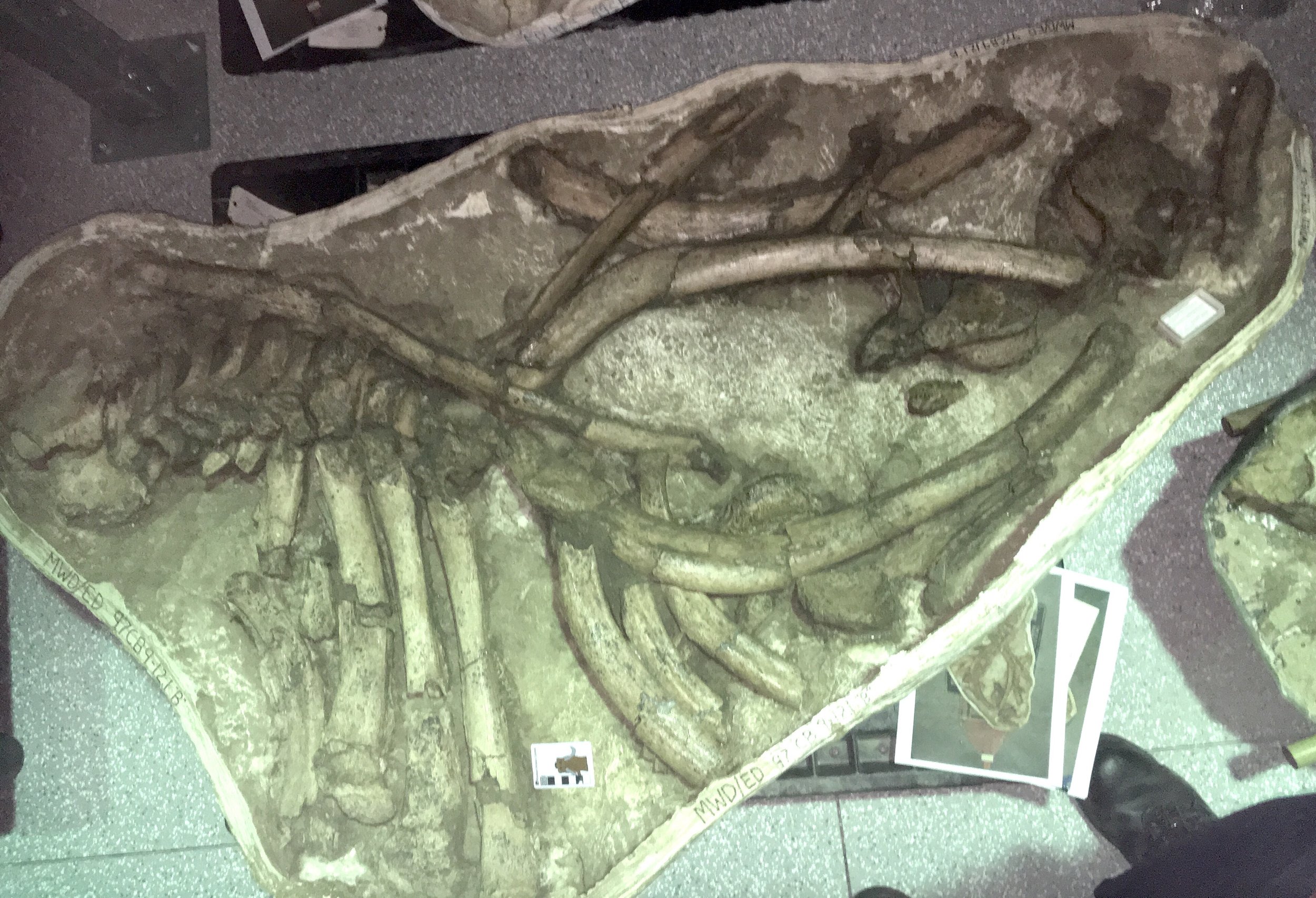 California mastodons have been in the news lately, so I decided to go with one of our Diamond Valley Lake mastodons for Fossil Friday this week.The specimen shown above is a partially articulated skeleton from the East Dam of the lake, making it among our older mastodon skeletons (likely at least 35,000 years old). In the marked version below, vertebrae are highlighted in blue:
California mastodons have been in the news lately, so I decided to go with one of our Diamond Valley Lake mastodons for Fossil Friday this week.The specimen shown above is a partially articulated skeleton from the East Dam of the lake, making it among our older mastodon skeletons (likely at least 35,000 years old). In the marked version below, vertebrae are highlighted in blue: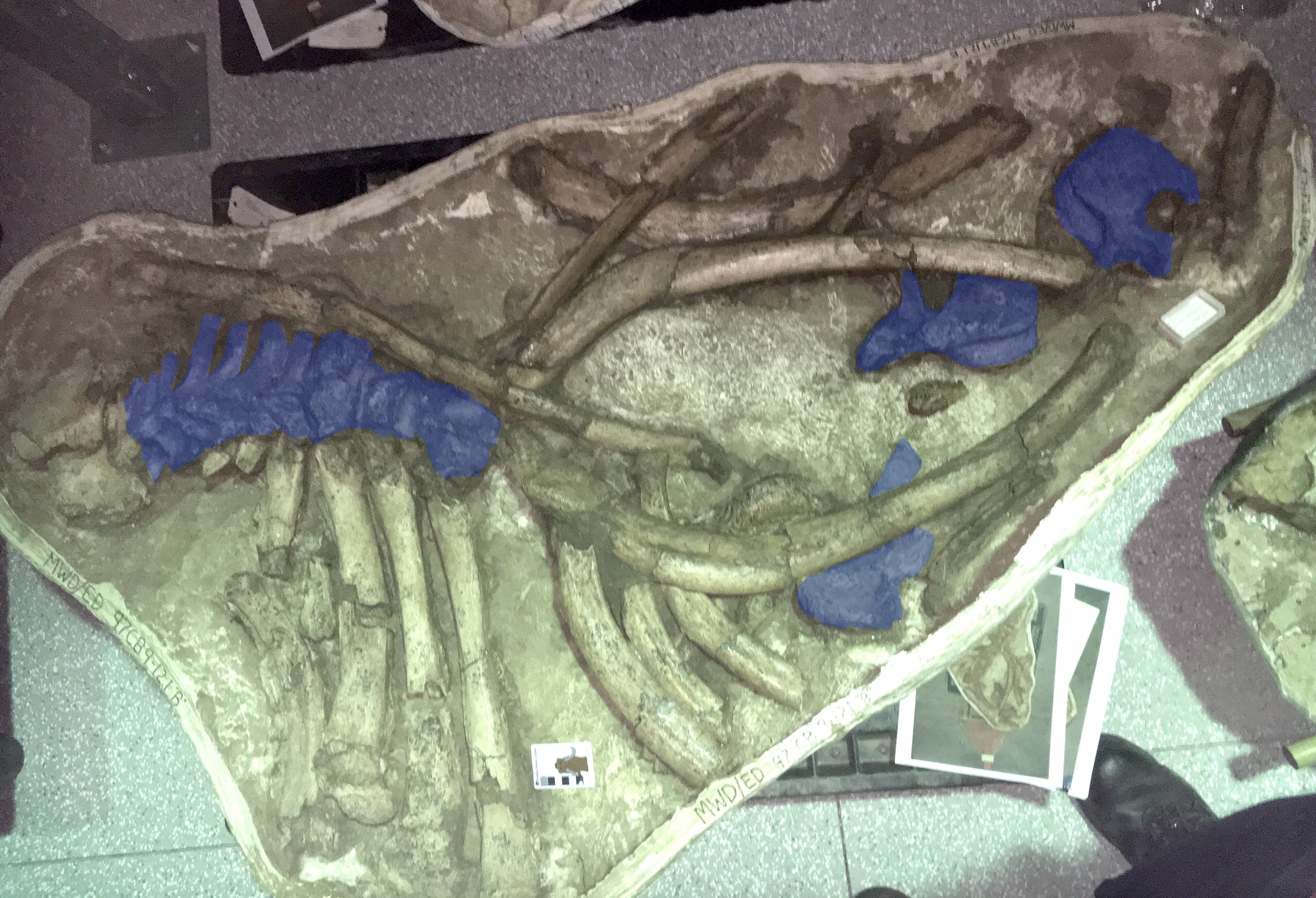 The anterior end of the skeleton is to the left. The anterior end of the thoracic region is still pretty well articulated (it's possible this may include the last few cervical vertebrae, but confirming this will require closer examination). Further back, on the right, the skeleton becomes more scattered, and it appears a number of vertebrae are missing. The vertebra in the upper right corner is especially interesting; a closeup is below:
The anterior end of the skeleton is to the left. The anterior end of the thoracic region is still pretty well articulated (it's possible this may include the last few cervical vertebrae, but confirming this will require closer examination). Further back, on the right, the skeleton becomes more scattered, and it appears a number of vertebrae are missing. The vertebra in the upper right corner is especially interesting; a closeup is below: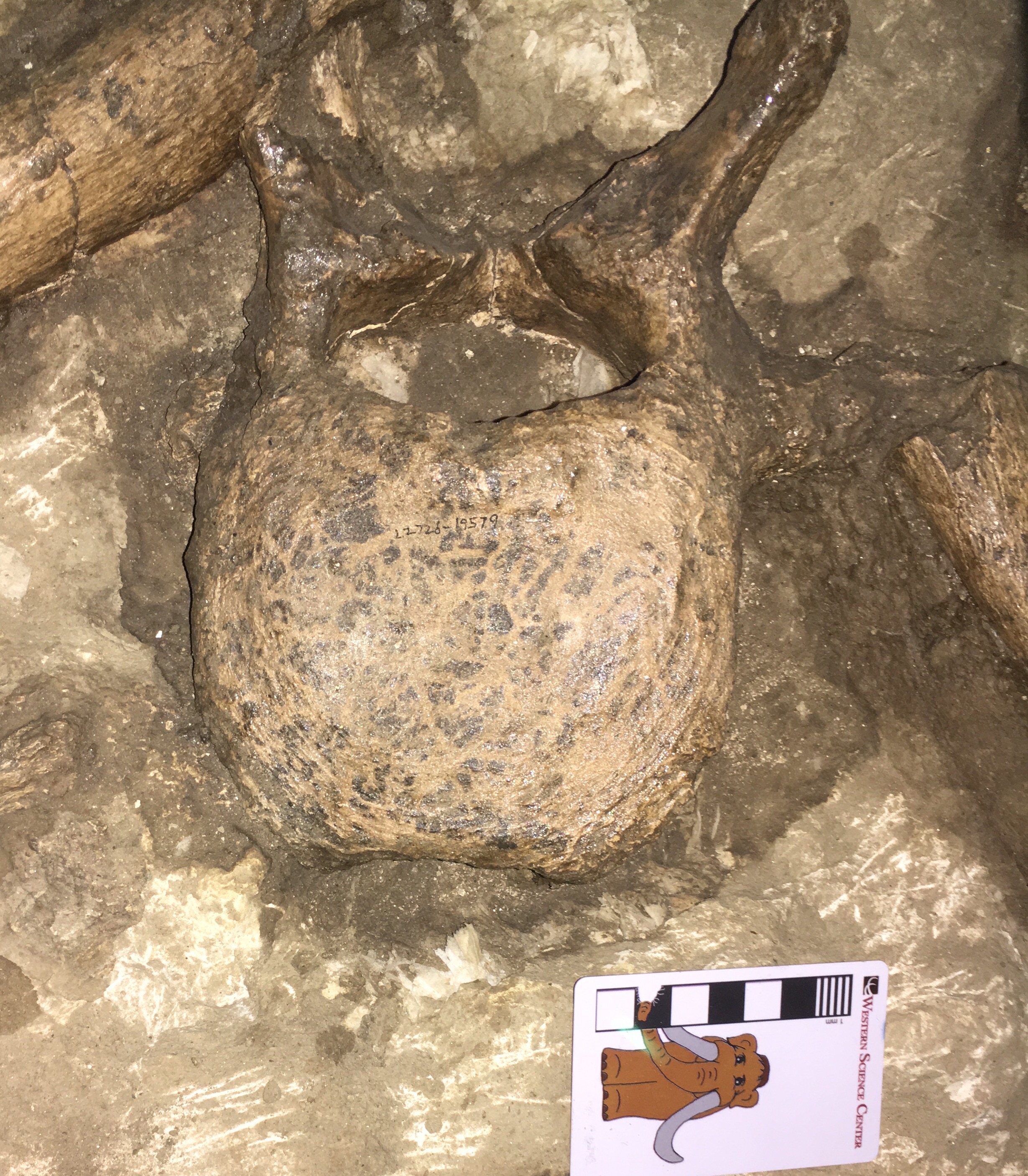 The rectangular vertebral centrum is typical of the posterior thoracic and lumbar vertebrae in mastodons, and is quite different from the centrum shape in mammoths (which are taller and more pointed at the bottom), confirming the identity of this specimen as a mastodon.At least one of the ribs has notches along the margin that are consistent with marks caused by gnawing rodents:
The rectangular vertebral centrum is typical of the posterior thoracic and lumbar vertebrae in mastodons, and is quite different from the centrum shape in mammoths (which are taller and more pointed at the bottom), confirming the identity of this specimen as a mastodon.At least one of the ribs has notches along the margin that are consistent with marks caused by gnawing rodents: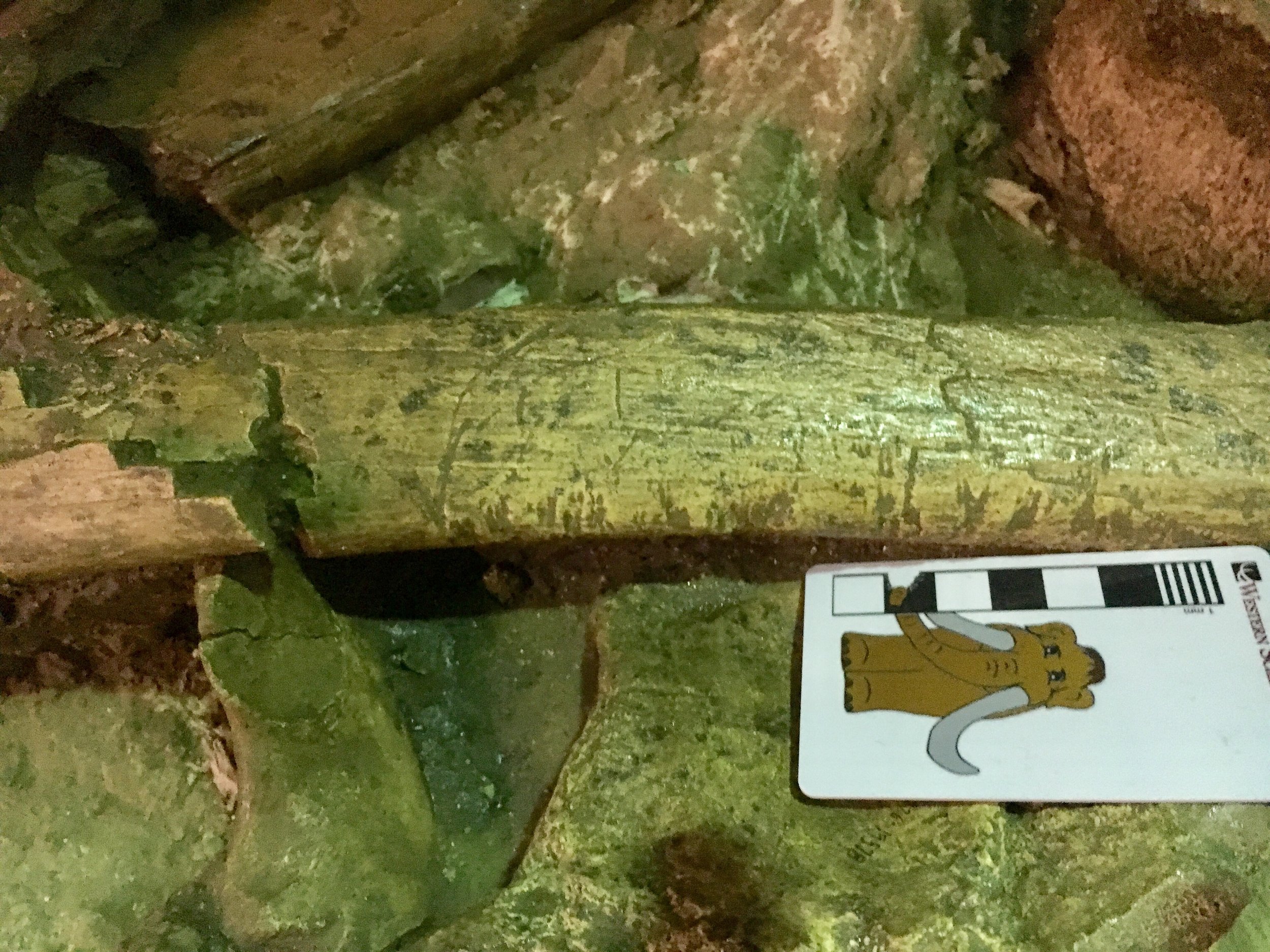 Of course, the big media news this week was a report (Holen et al. 2017) of a 130,000-year-old mastodon from San Diego that was supposedly worked by humans, more than 100,000 years before humans were thought to have arrived in North America. I have read the paper and I'm currently reading the supplemental material. The paper is quite detailed, and while I'm impressed with their arguments I remain unconvinced of their interpretation. While I feel the age is likely correct, I question their interpretation that the damage seen on the bones could only have been caused by humans; there needs to be a much better demonstration that human activity is the only reasonable explanation for their observations. Human teeth, cranial bones, jaws, vertebrae, and limb elements are all easily identified, yet no scrap of human bone has turned up even in areas with extensive collections such as Diamond Valley Lake, even in 30-40,000 year old sediments that are young enough to date using C14. For what i's worth, while a few people have suggested otherwise, I see no eveidence of any human working of the Pleistocene bones from Diamond Valley Lake, and there's no evidence of human habitation from the Valley during the Ice Age, even though there are extensive archaeological remains in the Valley that post-date the Ice Age.
Of course, the big media news this week was a report (Holen et al. 2017) of a 130,000-year-old mastodon from San Diego that was supposedly worked by humans, more than 100,000 years before humans were thought to have arrived in North America. I have read the paper and I'm currently reading the supplemental material. The paper is quite detailed, and while I'm impressed with their arguments I remain unconvinced of their interpretation. While I feel the age is likely correct, I question their interpretation that the damage seen on the bones could only have been caused by humans; there needs to be a much better demonstration that human activity is the only reasonable explanation for their observations. Human teeth, cranial bones, jaws, vertebrae, and limb elements are all easily identified, yet no scrap of human bone has turned up even in areas with extensive collections such as Diamond Valley Lake, even in 30-40,000 year old sediments that are young enough to date using C14. For what i's worth, while a few people have suggested otherwise, I see no eveidence of any human working of the Pleistocene bones from Diamond Valley Lake, and there's no evidence of human habitation from the Valley during the Ice Age, even though there are extensive archaeological remains in the Valley that post-date the Ice Age.
Fossil Friday - possible bobcat tooth
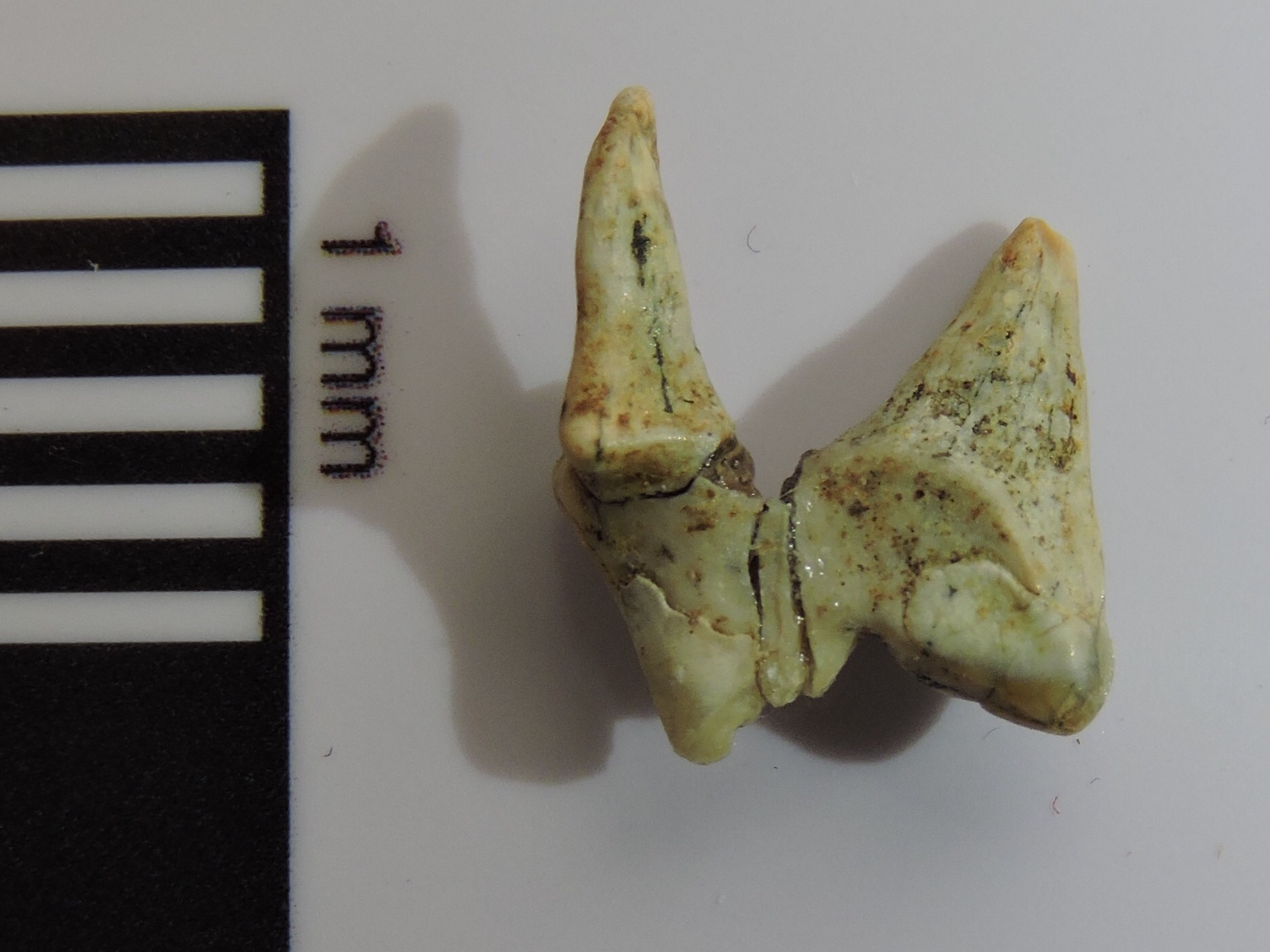 Confession time: I'm not an expert on most of the organisms I feature on Fossil Friday, and it sometimes takes me a fair bit of research to work out what I'm going to say. Because of that, when I'm swamped with other work (like this week), I will usually pick a Fossil Friday specimen that is straightforward so that I can write about it quickly. But sometimes the choice backfires.One of the rarest fossils from Diamond Valley Lake is the bobcat, represented by a single tooth and possibly two other bones. Confirming the identity of a bobcat tooth should be relatively straightforward, especially since we recently acquired a modern bobcat skull for comparison. Our database indicated that the single tooth is a lower first molar, broken into three fragments. In carnivorans such as cats, the lower 1st molar is modified into a large blade-shaped tooth. The upper 4th premolar is modified in a similar way, and these two teeth (called the carnassials) occlude like a pair of scissors, slicing up meat. A quick glance at the three tooth fragments confirmed that the carnassial blade structure was present. As long as I had the tooth out, I decided to glue the fragments back together, with the result shown above in lingual view and below in labial view.
Confession time: I'm not an expert on most of the organisms I feature on Fossil Friday, and it sometimes takes me a fair bit of research to work out what I'm going to say. Because of that, when I'm swamped with other work (like this week), I will usually pick a Fossil Friday specimen that is straightforward so that I can write about it quickly. But sometimes the choice backfires.One of the rarest fossils from Diamond Valley Lake is the bobcat, represented by a single tooth and possibly two other bones. Confirming the identity of a bobcat tooth should be relatively straightforward, especially since we recently acquired a modern bobcat skull for comparison. Our database indicated that the single tooth is a lower first molar, broken into three fragments. In carnivorans such as cats, the lower 1st molar is modified into a large blade-shaped tooth. The upper 4th premolar is modified in a similar way, and these two teeth (called the carnassials) occlude like a pair of scissors, slicing up meat. A quick glance at the three tooth fragments confirmed that the carnassial blade structure was present. As long as I had the tooth out, I decided to glue the fragments back together, with the result shown above in lingual view and below in labial view. The tooth still shows a lot of damage, but one thing that was immediately clear was that the tooth originally had three roots; that meant it was an upper tooth. Instead of a lower left 1st molar, it's actually an upper right 4th premolar. Here's an occlusal view of the tooth:
The tooth still shows a lot of damage, but one thing that was immediately clear was that the tooth originally had three roots; that meant it was an upper tooth. Instead of a lower left 1st molar, it's actually an upper right 4th premolar. Here's an occlusal view of the tooth: The knob projecting to the upper right (toward the front and middling of the skull, or "anterolingually") is called the protocone. A root is located directly under the protocone. The protocone and its associated root were broken off as a separate piece, which I suspect is what caused the misidentification.So, now that the tooth is an upper 4th premolar instead of a lower 1st molar, can we still call it a bobcat? Unfortunately, that's not entirely clear. Below is an occlusal view of a bobcat's upper 4th premolar:
The knob projecting to the upper right (toward the front and middling of the skull, or "anterolingually") is called the protocone. A root is located directly under the protocone. The protocone and its associated root were broken off as a separate piece, which I suspect is what caused the misidentification.So, now that the tooth is an upper 4th premolar instead of a lower 1st molar, can we still call it a bobcat? Unfortunately, that's not entirely clear. Below is an occlusal view of a bobcat's upper 4th premolar: While these teeth are similar in some ways, there are some important differences. For example, the lingual edge of the tooth is slightly convex in the bobcat, but slightly concave in the DVL specimen. The bobcat tooth is also about 10% larger.In terms of size, the DVL tooth is actually closer to a gray fox:
While these teeth are similar in some ways, there are some important differences. For example, the lingual edge of the tooth is slightly convex in the bobcat, but slightly concave in the DVL specimen. The bobcat tooth is also about 10% larger.In terms of size, the DVL tooth is actually closer to a gray fox: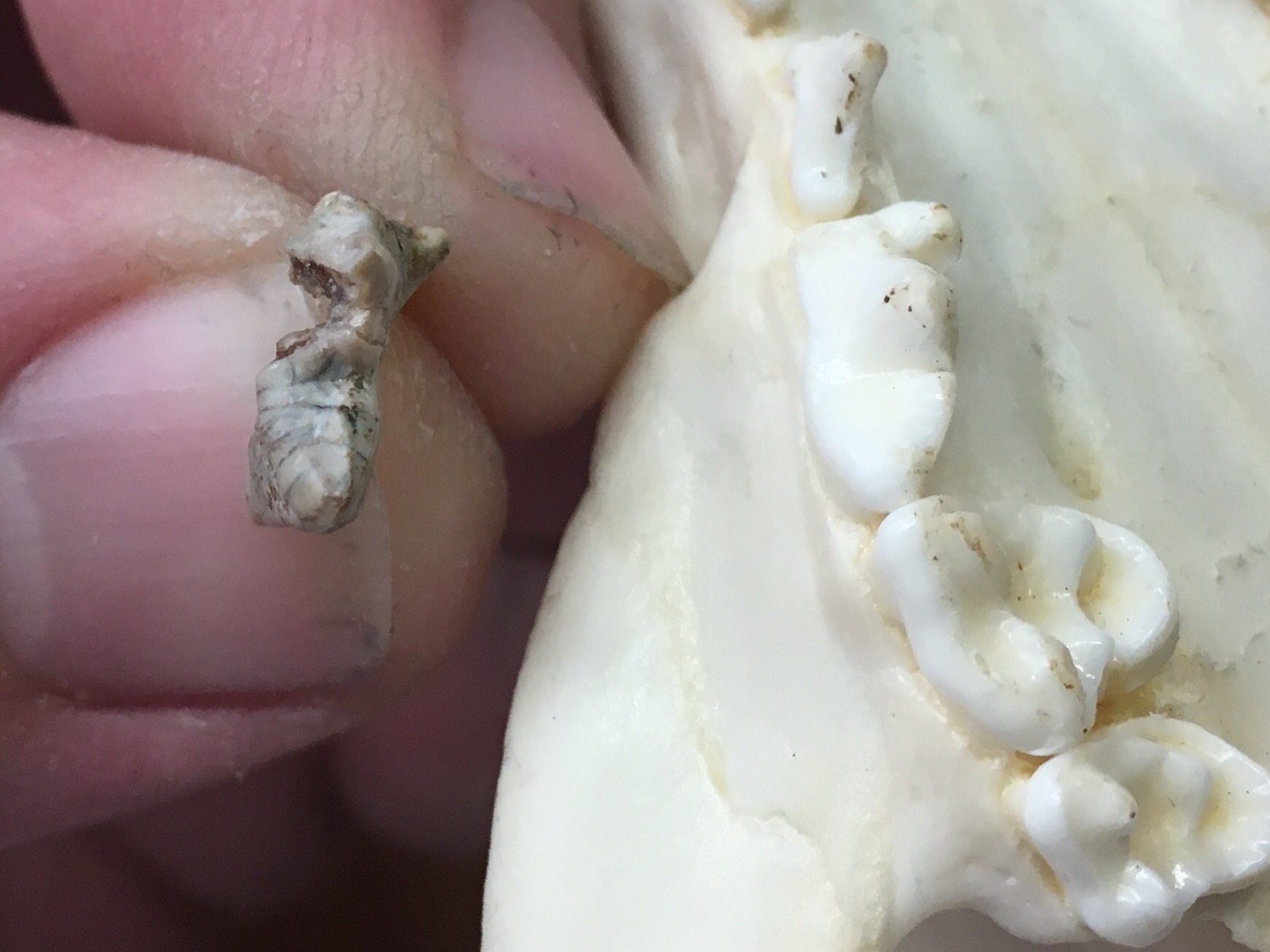 While the size is good, the shape of the DVL tooth still differs quite a bit from the gray fox, particularly the shape of the anterior edge. On balance, in spite of the size, I think this tooth is still more similar to a bobcat than anything else I've seen. Until we can study it further, I think we can tentatively call it a bobcat.
While the size is good, the shape of the DVL tooth still differs quite a bit from the gray fox, particularly the shape of the anterior edge. On balance, in spite of the size, I think this tooth is still more similar to a bobcat than anything else I've seen. Until we can study it further, I think we can tentatively call it a bobcat.
Fossil Friday - possible mastodon bones
 A common theme on this blog is that we can often get a lot of information from very incomplete material. Even so, as a general rule, the more remains we have from a given fossil organism, the more we can say about it. But sometimes we can have multiple bones, and even something as basic as a species identification can be elusive.The small field jacket shown above was collected from the West Dam of Diamond Valley Lake. There are several bones present, all consistent with a single individual. An annotated version is shown below:
A common theme on this blog is that we can often get a lot of information from very incomplete material. Even so, as a general rule, the more remains we have from a given fossil organism, the more we can say about it. But sometimes we can have multiple bones, and even something as basic as a species identification can be elusive.The small field jacket shown above was collected from the West Dam of Diamond Valley Lake. There are several bones present, all consistent with a single individual. An annotated version is shown below: The bone highlighted in blue is the distal end of the left femur. Those in red are ribs, the yellow are thoracic vertebrae, and the purple are unidentified. The size and general shape indicate that these are proboscidean bones, but there are two species from Diamond Valley Lake: the mammoth Mammuthus columbi and the mastodon Mammut americanum. While mastodons are much more common at DVL, numerous mammoth remains were also found. Which species is represented by these bones?Obviously our unidentified bones are not going to be of much help here. Ribs are also notoriously difficult to identify, especially if they're incomplete.The femur is potentially more useful. Femora have lots of distinctive features, and they differ between mammoths and mastodons. The most obvious difference is that mastodon femora are much more robust, while mammoth femora are rather long and slender. Unfortunately, this is difficult to evaluate unless a substantial portion of the femur (roughly half) is preserved. We only have about the distal fourth of the femur, and that is poorly preserved and partially hidden under the other bones. The medial condyle (the large curved knob at the end of the femur) does seem quite large, and this may suggest that a mastodon is more likely, but that's not much to go on.How about the vertebrae? In most vertebral positions mammoth and mastodon vertebrae are quite different. For example, in anterior view the lumbar vertebrae of mastodons have nearly rectangular centra that are wider than tall, while in mammoths they are more heart-shaped and are taller than wide. These vertebrae appear to be posterior thoracic vertebrae. Unfortunately, mammoth and mastodon posterior thoracics are very similar to each other. Mammoths tend to have much longer neural spines on these vertebrae, but the spines are incomplete in this specimen. Mastodons have a slightly taller and differently shaped neural canal, that seems a little more similar to these bones, but it seems this trait is quite variable.The only other hint may be the size. By proboscidean standards, these bones are not particularly large. Even though they're fairly small, they come from a more-or-less adult animal; the condyles are fused to the femur, and the vertebral epiphyses are fused to their centra, both of which indicate an animal that was mostly finished growing. Mammoths were larger than mastodons on average, so that suggests that a mastodon might be more likely (and, of course, mastodons are three times more common at DVL than mammoths).So, which is it? I don't know. I lean toward mastodon, and most of the observations seem to point that way, but that's with a lot of "mays", "seems", "suggests", and other tentative qualifiers. Sometimes, it's hard to say for sure.
The bone highlighted in blue is the distal end of the left femur. Those in red are ribs, the yellow are thoracic vertebrae, and the purple are unidentified. The size and general shape indicate that these are proboscidean bones, but there are two species from Diamond Valley Lake: the mammoth Mammuthus columbi and the mastodon Mammut americanum. While mastodons are much more common at DVL, numerous mammoth remains were also found. Which species is represented by these bones?Obviously our unidentified bones are not going to be of much help here. Ribs are also notoriously difficult to identify, especially if they're incomplete.The femur is potentially more useful. Femora have lots of distinctive features, and they differ between mammoths and mastodons. The most obvious difference is that mastodon femora are much more robust, while mammoth femora are rather long and slender. Unfortunately, this is difficult to evaluate unless a substantial portion of the femur (roughly half) is preserved. We only have about the distal fourth of the femur, and that is poorly preserved and partially hidden under the other bones. The medial condyle (the large curved knob at the end of the femur) does seem quite large, and this may suggest that a mastodon is more likely, but that's not much to go on.How about the vertebrae? In most vertebral positions mammoth and mastodon vertebrae are quite different. For example, in anterior view the lumbar vertebrae of mastodons have nearly rectangular centra that are wider than tall, while in mammoths they are more heart-shaped and are taller than wide. These vertebrae appear to be posterior thoracic vertebrae. Unfortunately, mammoth and mastodon posterior thoracics are very similar to each other. Mammoths tend to have much longer neural spines on these vertebrae, but the spines are incomplete in this specimen. Mastodons have a slightly taller and differently shaped neural canal, that seems a little more similar to these bones, but it seems this trait is quite variable.The only other hint may be the size. By proboscidean standards, these bones are not particularly large. Even though they're fairly small, they come from a more-or-less adult animal; the condyles are fused to the femur, and the vertebral epiphyses are fused to their centra, both of which indicate an animal that was mostly finished growing. Mammoths were larger than mastodons on average, so that suggests that a mastodon might be more likely (and, of course, mastodons are three times more common at DVL than mammoths).So, which is it? I don't know. I lean toward mastodon, and most of the observations seem to point that way, but that's with a lot of "mays", "seems", "suggests", and other tentative qualifiers. Sometimes, it's hard to say for sure.
Fossil Friday - mammoth tooth
 With the influence of Max Mastodon, Diamond Valley Lake mammoths sometimes get short shrift around here. But while DVL mammoths are not nearly as common as mastodons, there is still plenty of interesting mammoth material.The tooth shown above is an upper molar, probably the second molar, with the anterior end of the tooth to the right. This is the occlusal view showing the transverse enamel ridges that are typical of mammoths and other members of the family Elephantidae, including the modern elephants. (Mastodons are proboscideans, but not elephantids, which is reflected in their different tooth structure.) Below is a medial view, with anterior to the left:
With the influence of Max Mastodon, Diamond Valley Lake mammoths sometimes get short shrift around here. But while DVL mammoths are not nearly as common as mastodons, there is still plenty of interesting mammoth material.The tooth shown above is an upper molar, probably the second molar, with the anterior end of the tooth to the right. This is the occlusal view showing the transverse enamel ridges that are typical of mammoths and other members of the family Elephantidae, including the modern elephants. (Mastodons are proboscideans, but not elephantids, which is reflected in their different tooth structure.) Below is a medial view, with anterior to the left: Because mammoths (like other advanced proboscideans) had horizontal tooth replacement, the anterior end of the tooth erupts first, with the upper teeth moving forward and down over time. That means the front of the tooth has seen more use than the back of the tooth, which is clear in medial view. The front of the tooth is very short because it has been almost completely worn away, while the back of the tooth is still tall, with very little wear.This specimen, which was associated with another tooth and several other cranial fragments, was recovered from near the East Dam of Diamond Valley Lake. Most of the dated sediments from that end of the lake are among the older DVL deposits, from about 35,000 to 45,000 years old.
Because mammoths (like other advanced proboscideans) had horizontal tooth replacement, the anterior end of the tooth erupts first, with the upper teeth moving forward and down over time. That means the front of the tooth has seen more use than the back of the tooth, which is clear in medial view. The front of the tooth is very short because it has been almost completely worn away, while the back of the tooth is still tall, with very little wear.This specimen, which was associated with another tooth and several other cranial fragments, was recovered from near the East Dam of Diamond Valley Lake. Most of the dated sediments from that end of the lake are among the older DVL deposits, from about 35,000 to 45,000 years old.
Fossil Friday - horse metacarpal
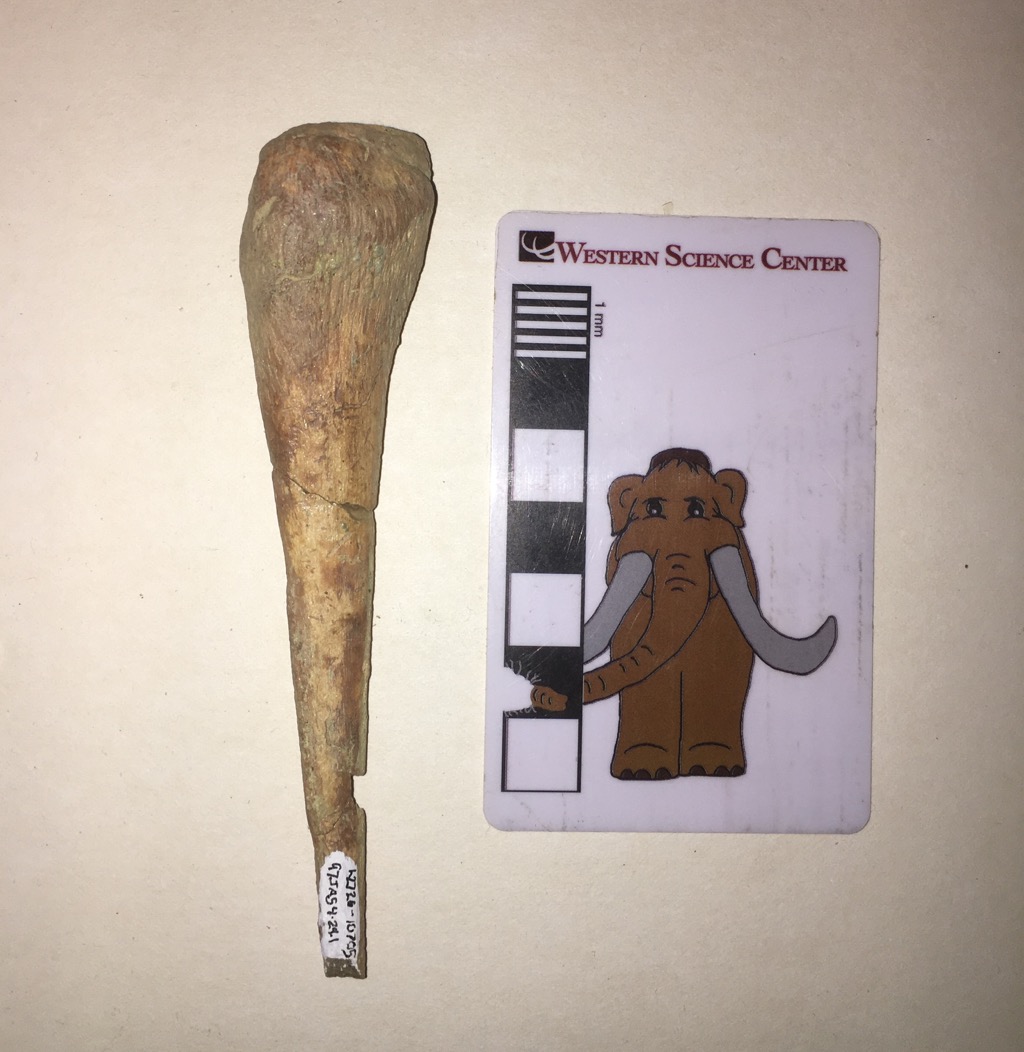 One of the joys of paleontology is that every fossil has a story. Through our understanding of anatomy, geology, ecology, and a host of other field, we can often reveal part of that story, and even a relatively small, nondescript fossil takes on a larger meaning.The small, pointed bone shown above is the right fourth metacarpal from a horse (Equus). The metacarpals are the bones that make up the hand or forefoot. At the proximal end they articulate with the wrist bones (the carpals) and often with the adjacent metacarpals. At the distal end they normally articulate with the first finger bones (the phalanges). In humans, the fourth metacarpal articulates with the ring finger. Our fingers (or digits) are numbered from 1 to 5, with the thumb being Digit I and the pinkie finger being Digit V; thus the ring finger is Digit IV. Toes are numbered the same way, with the big toe as Digit I.Horses famously only have a single hoof on each foot, corresponding to a single finger (on the front feet) or toe (on the back feet). The distal end of the bone shown above (at the bottom of the photo) clearly does not have any kind of articulation for the bones that make up the single finger on the horse's right foot. So what's going on?In horses, the hand bone that supports the animal's weight is the third metacarpal, not the fourth one. The right third metacarpal (probably from the same individual) is shown below:
One of the joys of paleontology is that every fossil has a story. Through our understanding of anatomy, geology, ecology, and a host of other field, we can often reveal part of that story, and even a relatively small, nondescript fossil takes on a larger meaning.The small, pointed bone shown above is the right fourth metacarpal from a horse (Equus). The metacarpals are the bones that make up the hand or forefoot. At the proximal end they articulate with the wrist bones (the carpals) and often with the adjacent metacarpals. At the distal end they normally articulate with the first finger bones (the phalanges). In humans, the fourth metacarpal articulates with the ring finger. Our fingers (or digits) are numbered from 1 to 5, with the thumb being Digit I and the pinkie finger being Digit V; thus the ring finger is Digit IV. Toes are numbered the same way, with the big toe as Digit I.Horses famously only have a single hoof on each foot, corresponding to a single finger (on the front feet) or toe (on the back feet). The distal end of the bone shown above (at the bottom of the photo) clearly does not have any kind of articulation for the bones that make up the single finger on the horse's right foot. So what's going on?In horses, the hand bone that supports the animal's weight is the third metacarpal, not the fourth one. The right third metacarpal (probably from the same individual) is shown below: 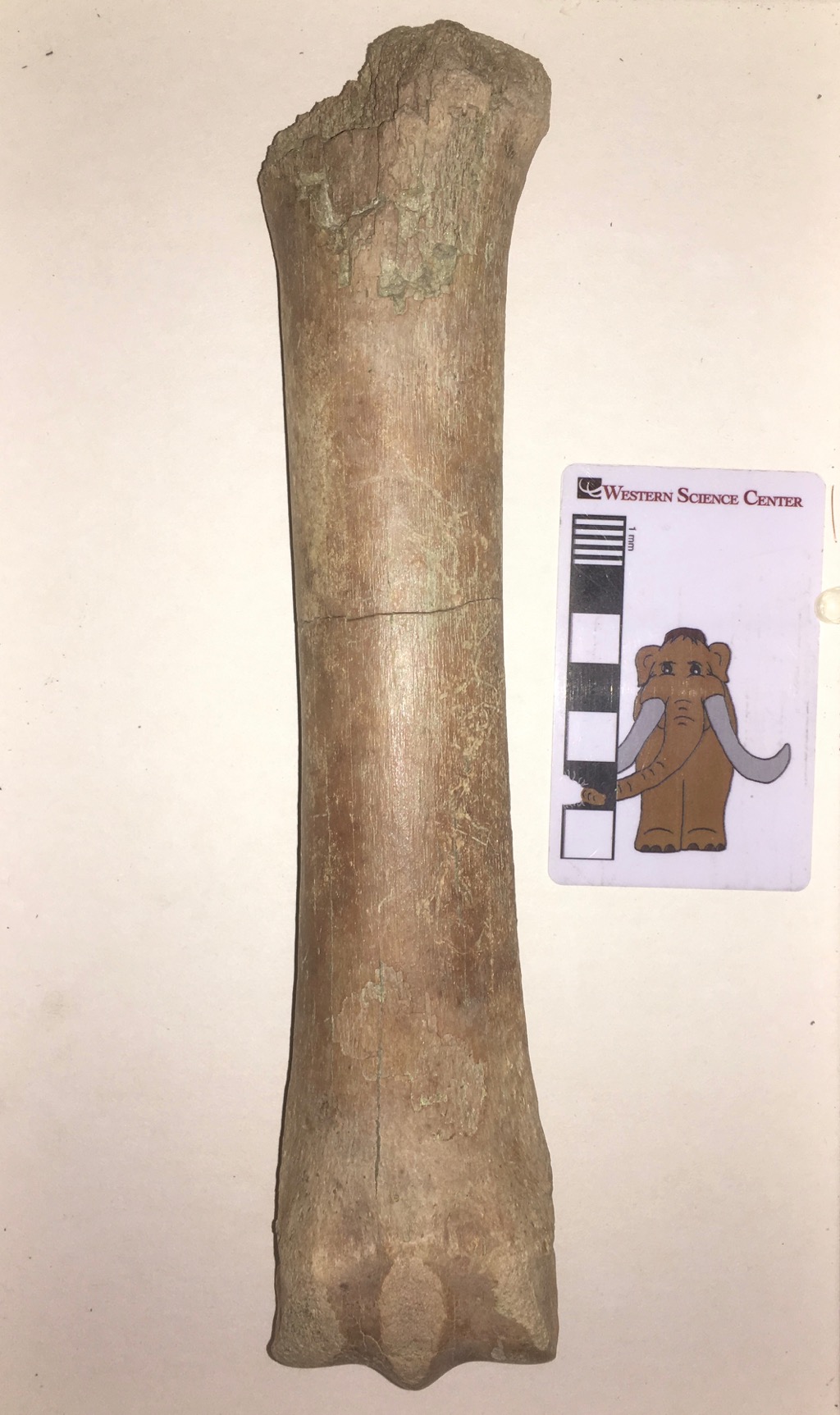 This massive bone is well-suited to holding up a horse's weight. So what about the fourth metacarpal? If it doesn't support a hoof, what does it do?As far as we can tell, pretty much nothing.The fourth metacarpal is a remnant of the horse's evolutionary history. While modern Equus is limited to a single hoof on each foot, supported by Digit III, horses' ancestors and extinct relatives had multiple hooves on each foot. The lateral toes were gradually lost, starting with Digits I and V, and later with Digits II and IV. The key here is gradually. Each digit eventually became small enough that it no longer functioned for walking; there would be a tiny hoof, but it didn't reach the ground. The hoof would eventually be lost, leaving only the metacarpal with no attached finger or toe. After even more time and generations, even the metacarpal is lost. But the whole process takes several million years.In the horse lineage, the first and fifth metacarpals were lost tens of millions of years ago. But the reduction of the second and fourth metacarpals has happened much more recently. Within the last 10 million years horse ancestors still had functional second and fourth toes, even if they were smaller than the central third toe. A few million years ago the second and fourth toes were finally lost altogether, leaving their corresponding metacarpals and metatarsals as the last remaining remnants of these digits. And that's where horses are today. The second and fourth metacarpals (and metatarsals) have lost their toes, and even the articulation to attach to the toes, and they're greatly reduced in size. At the proximal end they still articulate with the wrist bones and the third metacarpal (see the posterior view below). The presence of the fourth metacarpal is evolution caught in the act, a snapshot of a dynamic process that seems static because it happens so slowly. If horses survive a few million more years, the fourth metacarpal will probably be entirely lost, so that there is only a small slice of time (geologically speaking) when such a fossil could be preserved.
This massive bone is well-suited to holding up a horse's weight. So what about the fourth metacarpal? If it doesn't support a hoof, what does it do?As far as we can tell, pretty much nothing.The fourth metacarpal is a remnant of the horse's evolutionary history. While modern Equus is limited to a single hoof on each foot, supported by Digit III, horses' ancestors and extinct relatives had multiple hooves on each foot. The lateral toes were gradually lost, starting with Digits I and V, and later with Digits II and IV. The key here is gradually. Each digit eventually became small enough that it no longer functioned for walking; there would be a tiny hoof, but it didn't reach the ground. The hoof would eventually be lost, leaving only the metacarpal with no attached finger or toe. After even more time and generations, even the metacarpal is lost. But the whole process takes several million years.In the horse lineage, the first and fifth metacarpals were lost tens of millions of years ago. But the reduction of the second and fourth metacarpals has happened much more recently. Within the last 10 million years horse ancestors still had functional second and fourth toes, even if they were smaller than the central third toe. A few million years ago the second and fourth toes were finally lost altogether, leaving their corresponding metacarpals and metatarsals as the last remaining remnants of these digits. And that's where horses are today. The second and fourth metacarpals (and metatarsals) have lost their toes, and even the articulation to attach to the toes, and they're greatly reduced in size. At the proximal end they still articulate with the wrist bones and the third metacarpal (see the posterior view below). The presence of the fourth metacarpal is evolution caught in the act, a snapshot of a dynamic process that seems static because it happens so slowly. If horses survive a few million more years, the fourth metacarpal will probably be entirely lost, so that there is only a small slice of time (geologically speaking) when such a fossil could be preserved.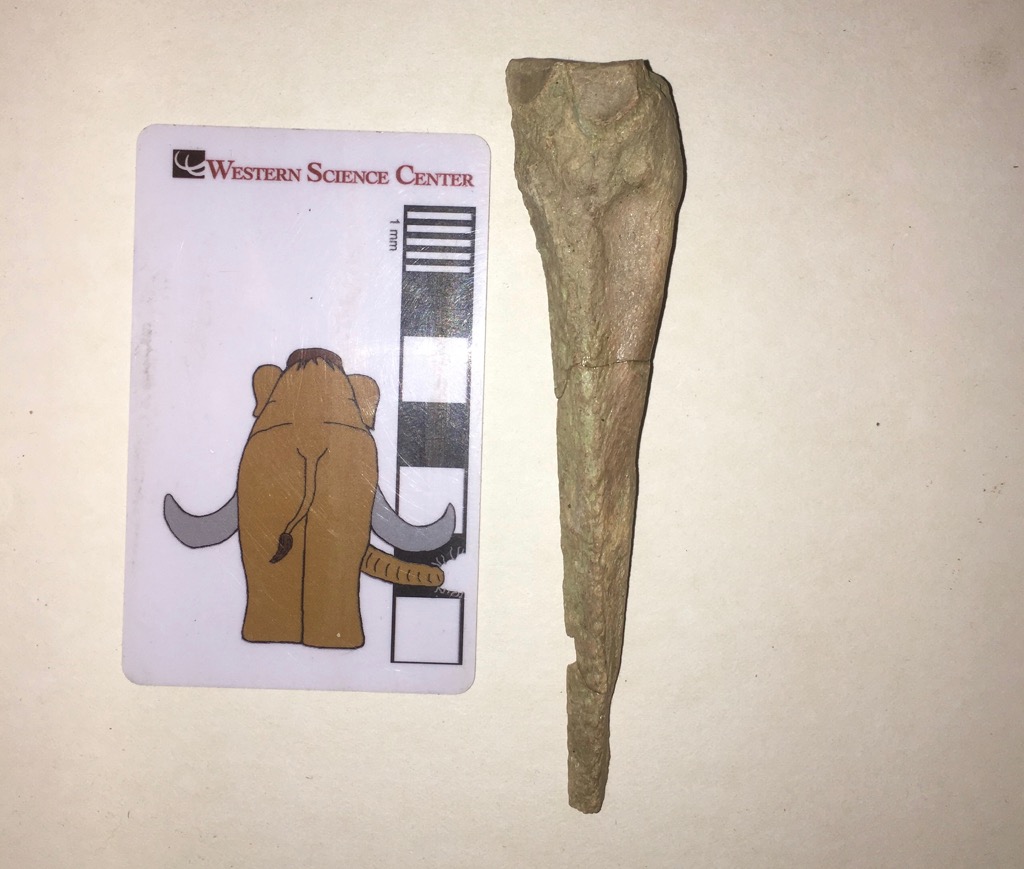
Fossil Friday - Paramylodon skull
 Even if a bone is lucky enough to be preserved as a fossil, time is not always kind. There are numerous ways a bone can be altered after burial, including being smushed by the weight of overlying sediment.The lump of bone shown above is actually a nearly complete skull of the ground sloth Paramylodon harlani in dorsal view, collected from the El Casco substation in northern Riverside County. It might be a little difficult to interpret because it has been deformed post-burial. Below is an annotated version:
Even if a bone is lucky enough to be preserved as a fossil, time is not always kind. There are numerous ways a bone can be altered after burial, including being smushed by the weight of overlying sediment.The lump of bone shown above is actually a nearly complete skull of the ground sloth Paramylodon harlani in dorsal view, collected from the El Casco substation in northern Riverside County. It might be a little difficult to interpret because it has been deformed post-burial. Below is an annotated version: The skull is pushed over so that the midline is displaced to the left. This makes features from the right side like the right eye socket easily visible in dorsal view, while hiding the same features from the left side. The entire skull is also flattened, resulting in the wide foramen magnum at the back of the skull.Here's the ventral view:
The skull is pushed over so that the midline is displaced to the left. This makes features from the right side like the right eye socket easily visible in dorsal view, while hiding the same features from the left side. The entire skull is also flattened, resulting in the wide foramen magnum at the back of the skull.Here's the ventral view: And the annotated version:
And the annotated version: Much of the basicranial part of the skull is a big-ole' indecipherable mess, but there are a lot of identifiable features, including all of the tooth sockets.While there are other Paramylodon remains from El Casco, this is the only sloth skull recovered from the site. Even deformed specimens can be significant!
Much of the basicranial part of the skull is a big-ole' indecipherable mess, but there are a lot of identifiable features, including all of the tooth sockets.While there are other Paramylodon remains from El Casco, this is the only sloth skull recovered from the site. Even deformed specimens can be significant!
Fossil Friday - tree frog humerus
 The majority of fossils from the Diamond Valley Lake deposits are from small animals. While small mammals are most common, there are substantial numbers of birds, reptiles, and amphibians.The bone shown above is a portion of a frog's left humerus, seen in ventral view; the bars behind it are 1 mm wide. Approximately the distal third of the bone is preserved, with the distal end (the elbow joint) on the right. The expanded distal end is divided into two parts; the larger, more spherical portion is the articular condyle, while the smaller medial portion (on the lower right) is the medial epicondyle.This humerus has been identified as Pseudacris sp.. Pseudacris is a widespread North American frog genus that includes various tree frogs, chorus frogs, and peepers, with several species still living in the southwestern US and Mexico. Below is an eastern example, a spring peeper (Pseudacris crucifer):
The majority of fossils from the Diamond Valley Lake deposits are from small animals. While small mammals are most common, there are substantial numbers of birds, reptiles, and amphibians.The bone shown above is a portion of a frog's left humerus, seen in ventral view; the bars behind it are 1 mm wide. Approximately the distal third of the bone is preserved, with the distal end (the elbow joint) on the right. The expanded distal end is divided into two parts; the larger, more spherical portion is the articular condyle, while the smaller medial portion (on the lower right) is the medial epicondyle.This humerus has been identified as Pseudacris sp.. Pseudacris is a widespread North American frog genus that includes various tree frogs, chorus frogs, and peepers, with several species still living in the southwestern US and Mexico. Below is an eastern example, a spring peeper (Pseudacris crucifer): An interesting feature of many frog species is that the humeri are sexually dimorphic. Males have a large flange, the crista medialis, that extends proximally from the medial epicondyle and make the humerus look much wider in ventral view. This specimen lacks a large crista medialis, so if that is a characteristic on Pseudacris it suggests this specimen is a female.
An interesting feature of many frog species is that the humeri are sexually dimorphic. Males have a large flange, the crista medialis, that extends proximally from the medial epicondyle and make the humerus look much wider in ventral view. This specimen lacks a large crista medialis, so if that is a characteristic on Pseudacris it suggests this specimen is a female.
Fossil Friday - Bison atlas vertebra, part 2
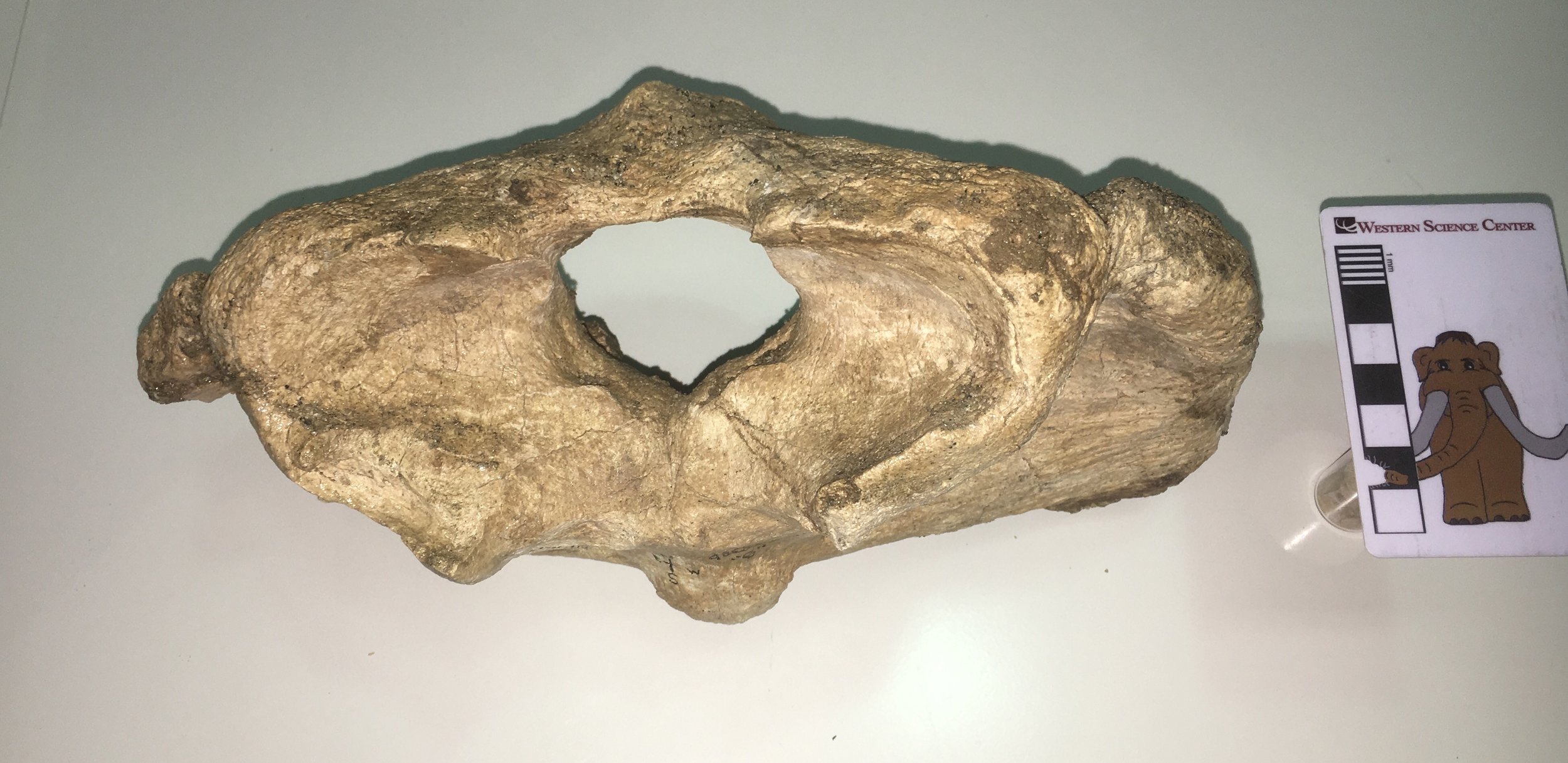 This week's Fossil Friday features one of Diamond Valley Lake's most common large mammals, the bison.Specifically, this bone is the atlas vertebra, the first vertebra in the neck. It's shown above in anterior view. The large hole in the bone is the neural canal, which carries the spinal cord in the live animal. The large concavities on each side of the neural canal are the articulations for the skull's occipital condyles.Below is the posterior view:
This week's Fossil Friday features one of Diamond Valley Lake's most common large mammals, the bison.Specifically, this bone is the atlas vertebra, the first vertebra in the neck. It's shown above in anterior view. The large hole in the bone is the neural canal, which carries the spinal cord in the live animal. The large concavities on each side of the neural canal are the articulations for the skull's occipital condyles.Below is the posterior view: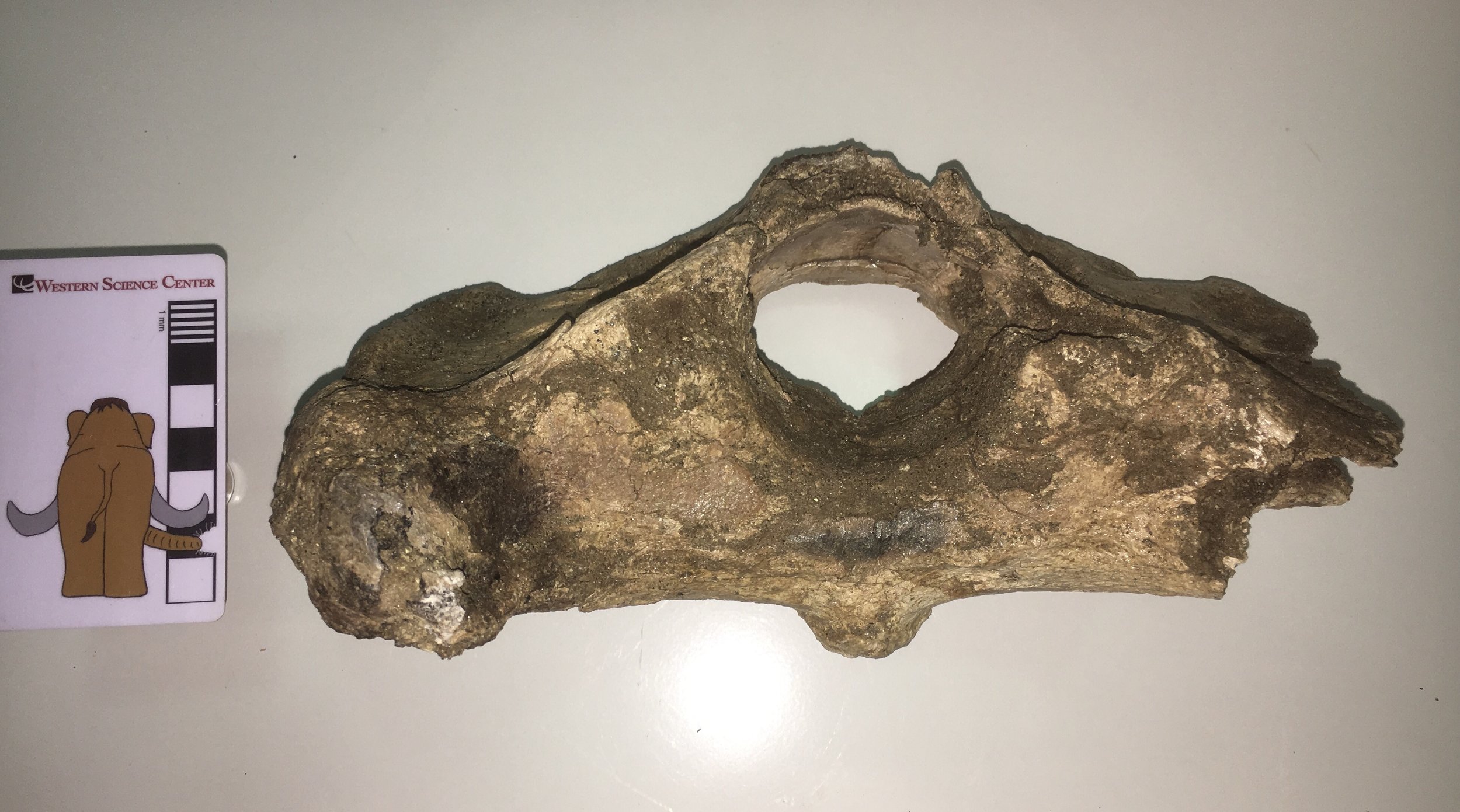 The preservation is a little rougher on this side. The posterior edge of the neural arch (the top of the neural canal) is missing, as is most of the right transverse process. The flat areas to each side of and slightly below the neural canal are the articular surfaces for the 2nd cervical vertebra, the axis.Here is the dorsal view:
The preservation is a little rougher on this side. The posterior edge of the neural arch (the top of the neural canal) is missing, as is most of the right transverse process. The flat areas to each side of and slightly below the neural canal are the articular surfaces for the 2nd cervical vertebra, the axis.Here is the dorsal view: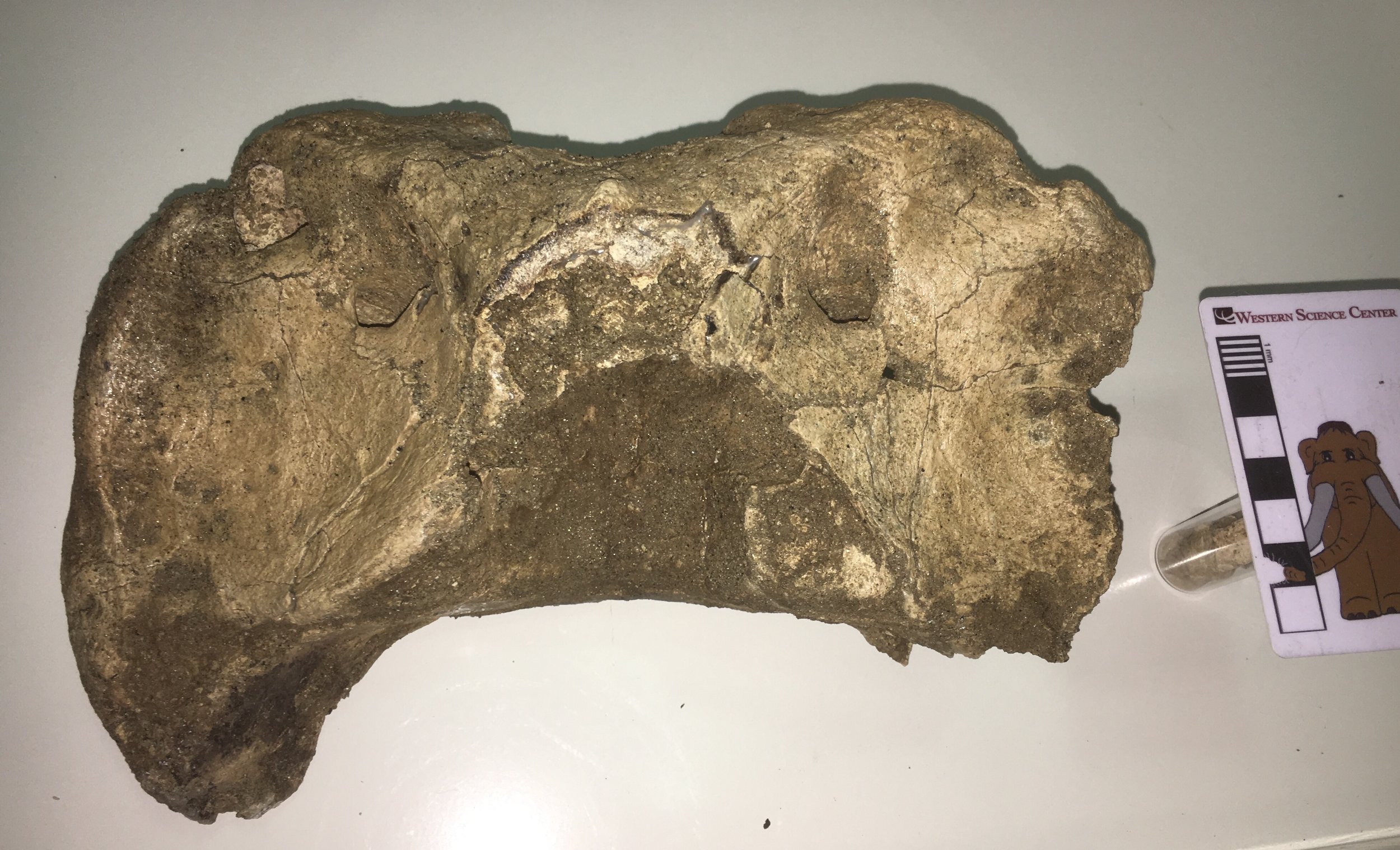 ...and the ventral view:
...and the ventral view: This vertebra is identified in our records as Bison antiquus. It comes from the West Dam area of the lake; sediments there are mostly less than 20,000 years old and seem to only produce Bison antiquus and not the large Bison latifrons. Bison antiquus is generally considered to be closely related or ancestral to the modern Bison bison, and indeed this atlas looks very similar to a modern bison's. This make an interesting contrast to the DVL bison atlas I wrote about back in May 2015. That vertebra was identified as Bison sp., but its shape is a bit different from this one (I even commented at the time that it differed from Bison bison). So perhaps our two extinct bison species really do have distinct atlas shapes. At some point we'll have to compare these bones to atlases that are associated with skulls to confirm that we're seeing specific differences and not individual or sexual variation.
This vertebra is identified in our records as Bison antiquus. It comes from the West Dam area of the lake; sediments there are mostly less than 20,000 years old and seem to only produce Bison antiquus and not the large Bison latifrons. Bison antiquus is generally considered to be closely related or ancestral to the modern Bison bison, and indeed this atlas looks very similar to a modern bison's. This make an interesting contrast to the DVL bison atlas I wrote about back in May 2015. That vertebra was identified as Bison sp., but its shape is a bit different from this one (I even commented at the time that it differed from Bison bison). So perhaps our two extinct bison species really do have distinct atlas shapes. At some point we'll have to compare these bones to atlases that are associated with skulls to confirm that we're seeing specific differences and not individual or sexual variation.
Fossil Friday - worn mastodon tooth
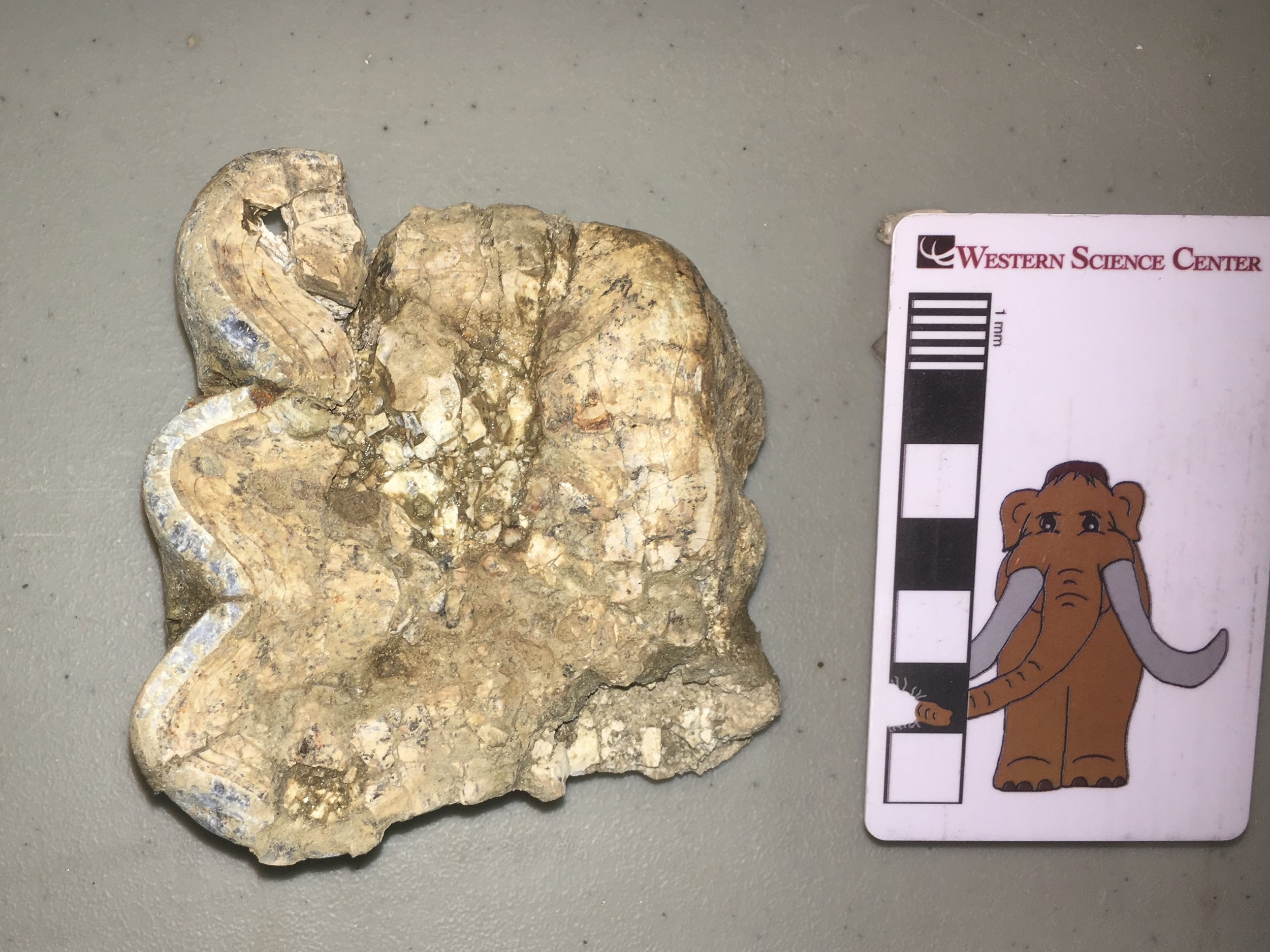 Volunteer Joe Reavis been hard at work on a collection of fossils from a mitigation project in Murrieta that includes a lot of mastodon material. As far as we can tell so far, all of the mastodon material is consistent with one individual, although we did confirm yesterday that there is non-mastodon material in the same collection.The specimen shown above is a molar from a mastodon. It's in pretty rough shape, but I think it's the upper right second molar. If that's correct, then the occlusal view above has anterior at the top, and the lateral side of the tooth is on the left. The three loops of enamel on the left are the remnants of three lophs, which indicates that this is either a 4th premolar, 1st molar, or 2nd molar (the 2nd and 3rd premolars only have 2 lophs, and the 3rd molar has 4 or 5 lophs). The length of the tooth is comparable to other 2nd molars in our collection.Upper teeth in mastodons wear more rapidly on the medial side than the lateral side. If we look at this tooth in lateral view, we can see that there is a only about 2 cm of enamel remaining; the rest of the lophs have been worn away:
Volunteer Joe Reavis been hard at work on a collection of fossils from a mitigation project in Murrieta that includes a lot of mastodon material. As far as we can tell so far, all of the mastodon material is consistent with one individual, although we did confirm yesterday that there is non-mastodon material in the same collection.The specimen shown above is a molar from a mastodon. It's in pretty rough shape, but I think it's the upper right second molar. If that's correct, then the occlusal view above has anterior at the top, and the lateral side of the tooth is on the left. The three loops of enamel on the left are the remnants of three lophs, which indicates that this is either a 4th premolar, 1st molar, or 2nd molar (the 2nd and 3rd premolars only have 2 lophs, and the 3rd molar has 4 or 5 lophs). The length of the tooth is comparable to other 2nd molars in our collection.Upper teeth in mastodons wear more rapidly on the medial side than the lateral side. If we look at this tooth in lateral view, we can see that there is a only about 2 cm of enamel remaining; the rest of the lophs have been worn away: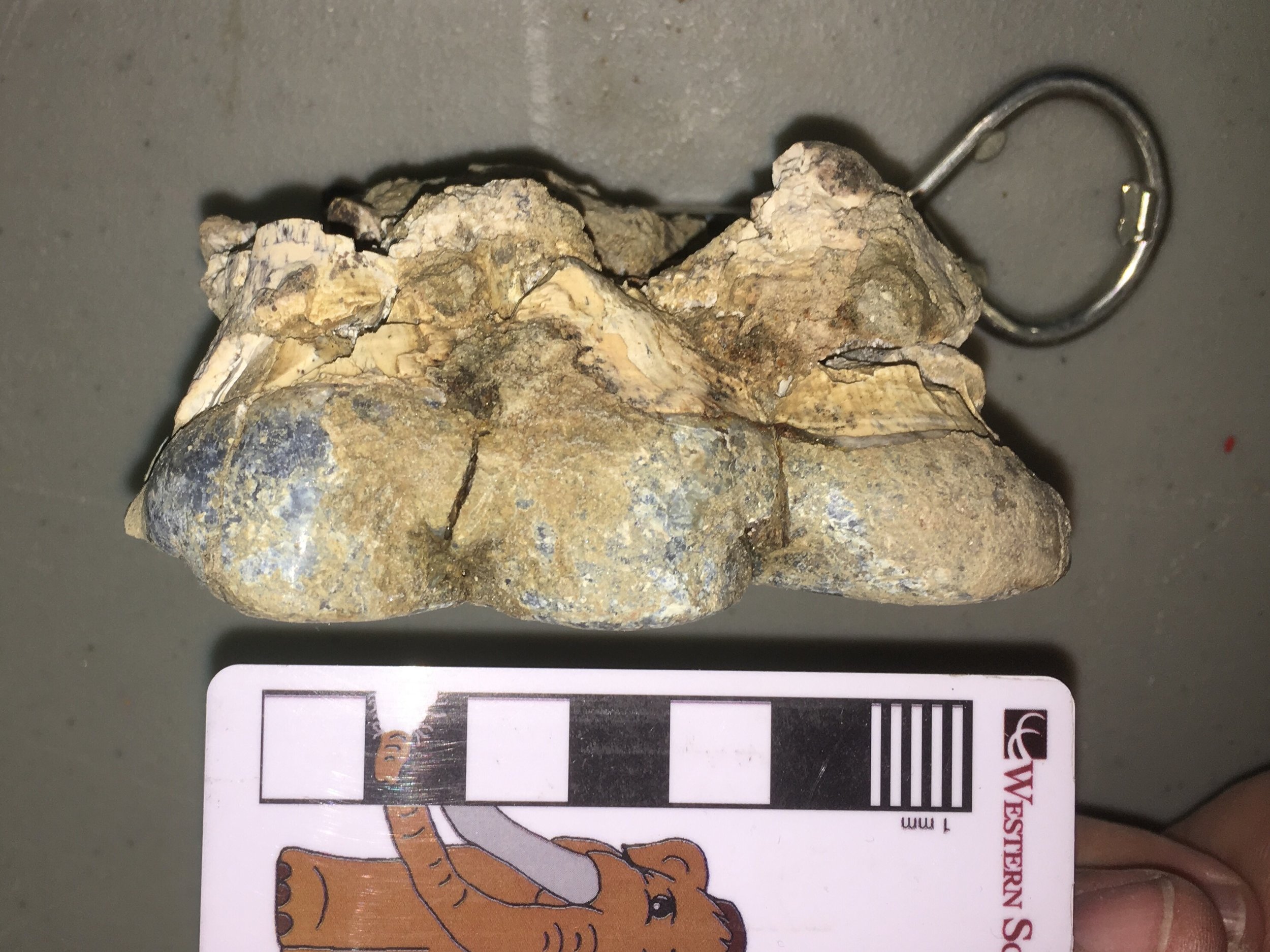 On the medial side, the wear is even more dramatic:
On the medial side, the wear is even more dramatic: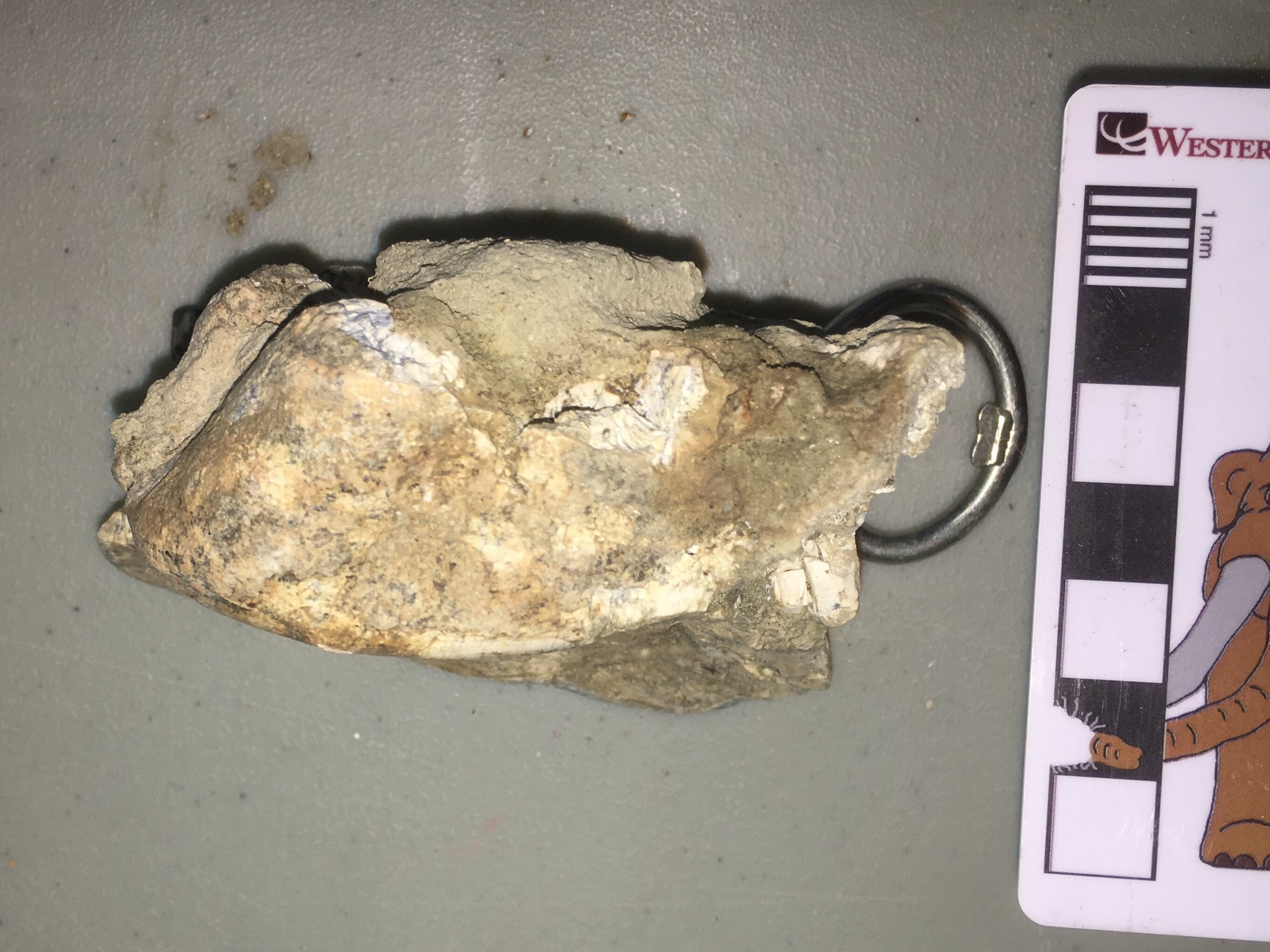 If you're having a hard time telling what's going on here, it's because the enamel is completely gone. The tooth is worn all the way down into the tops of the roots.In most animals this would indicate that the animal was very old, but the horizontal tooth replacement in mastodons and most other proboscideans changes the equation. The 2nd molar typically wears away and falls out sometime around age 40 (very approximately). This tooth still had its roots (they were broken post-mortem), so this mastodon was probably around 40 years old when it died.
If you're having a hard time telling what's going on here, it's because the enamel is completely gone. The tooth is worn all the way down into the tops of the roots.In most animals this would indicate that the animal was very old, but the horizontal tooth replacement in mastodons and most other proboscideans changes the equation. The 2nd molar typically wears away and falls out sometime around age 40 (very approximately). This tooth still had its roots (they were broken post-mortem), so this mastodon was probably around 40 years old when it died.
Fossil Friday - chewed-up Bison tibia
 I recently finished reading Anthony Martin's book about dinosaur trace fossils, Dinosaurs Without Bones, so I've had trace fossils on my mind. Even though I'm not a trace fossil specialist I find them intriguing, because they are essentially fossilized behavior. The bone shown here is the distal part of a right tibia from a bison (it's from the older end of the valley, so it could be either Bison antiquus or Bison latifrons). Above is the anterior view, with the bottom of the bone (at the ankle joint) on the left. The proximal part, including the knee joint, is missing. Below is the posterior view of the same bone:
I recently finished reading Anthony Martin's book about dinosaur trace fossils, Dinosaurs Without Bones, so I've had trace fossils on my mind. Even though I'm not a trace fossil specialist I find them intriguing, because they are essentially fossilized behavior. The bone shown here is the distal part of a right tibia from a bison (it's from the older end of the valley, so it could be either Bison antiquus or Bison latifrons). Above is the anterior view, with the bottom of the bone (at the ankle joint) on the left. The proximal part, including the knee joint, is missing. Below is the posterior view of the same bone: Even in these views, you may have noticed that the distal end of the bone is a little misshapen. Close-ups reveal that this bone is absolutely riddled with bite marks, presumably from a predator/scavenger gnawing on the bone:
Even in these views, you may have noticed that the distal end of the bone is a little misshapen. Close-ups reveal that this bone is absolutely riddled with bite marks, presumably from a predator/scavenger gnawing on the bone:


 The broken proximal end also has plenty of bite marks:
The broken proximal end also has plenty of bite marks:
 This bone is crying out for a more detailed study. There appear to be at least 2-3 different sets of scratches with different widths. Does this indicate that there were different-sized scavengers? If so, are we looking at different species taking turns (maybe dire wolves followed by coyotes), or different ages of the same species (adult wolves and their pups)? If the scratches show cross-cutting relationships, it might be possible to figure out if the big animals were eating before the small ones, or the other way around, or at the same time.
This bone is crying out for a more detailed study. There appear to be at least 2-3 different sets of scratches with different widths. Does this indicate that there were different-sized scavengers? If so, are we looking at different species taking turns (maybe dire wolves followed by coyotes), or different ages of the same species (adult wolves and their pups)? If the scratches show cross-cutting relationships, it might be possible to figure out if the big animals were eating before the small ones, or the other way around, or at the same time.
Fossil Friday - sloth mandible
 Greg McDonald's visit last month to look at sloth remains gave us a reason to open our display cases, which include some of our best sloth fossils.One of the exhibit specimens is a nearly complete mandible of Paramylodon harlani, the most common sloth from Diamond Valley Lake. The image is a dorsal view, with anterior to the right. The mandible is nearly complete, if a bit crushed. It's missing the articulation on the right side, part of the anterior end, and all the teeth, but is otherwise in good shape.Paramylodon lower jaws are scoop-shaped and toothless at the tip. This is very different from their distant relative Megalonyx, that has a pair of huge chisel-like teeth at the tip. Even though the teeth are missing, the shape of the sockets also reveals a different cross-section that the more rectangular teeth of Megalonyx. For additional examples of Paramylodon jaws, see our earlier Fossil Friday posts here and here.---This weekend I'll be at the Western Association of Vertebrate Paleontology meeting at Yavapai College in Arizona, presenting on the Mastodons of Unusual Size project and on the Stepping Out of the Past exhibit. Follow @MaxMastodon on Twitter for updates.
Greg McDonald's visit last month to look at sloth remains gave us a reason to open our display cases, which include some of our best sloth fossils.One of the exhibit specimens is a nearly complete mandible of Paramylodon harlani, the most common sloth from Diamond Valley Lake. The image is a dorsal view, with anterior to the right. The mandible is nearly complete, if a bit crushed. It's missing the articulation on the right side, part of the anterior end, and all the teeth, but is otherwise in good shape.Paramylodon lower jaws are scoop-shaped and toothless at the tip. This is very different from their distant relative Megalonyx, that has a pair of huge chisel-like teeth at the tip. Even though the teeth are missing, the shape of the sockets also reveals a different cross-section that the more rectangular teeth of Megalonyx. For additional examples of Paramylodon jaws, see our earlier Fossil Friday posts here and here.---This weekend I'll be at the Western Association of Vertebrate Paleontology meeting at Yavapai College in Arizona, presenting on the Mastodons of Unusual Size project and on the Stepping Out of the Past exhibit. Follow @MaxMastodon on Twitter for updates.
Fossil Friday - camel lumbar vertebra
 While we only have one well-preserved skull of the extinct camel Camelops hesternus from Diamond Valley Lake, we have a large number of post-cranial remains.The bone shown above is a lumbar vertebra, seen in anterior view. This seems to be the 7th lumbar, the last one in the series before the sacrum (which was also recovered from this individual, along with several other bones). The prominent curved structures above and on each side of the neural canal are the prezygopophyses. These articulated with the postzygophyses of the 6th lumbar. The strong curvature would largely lock the two vertebrae together, resulting in a relatively inflexible lumbar region.Here is the posterior view, with the postzygophyses visible:
While we only have one well-preserved skull of the extinct camel Camelops hesternus from Diamond Valley Lake, we have a large number of post-cranial remains.The bone shown above is a lumbar vertebra, seen in anterior view. This seems to be the 7th lumbar, the last one in the series before the sacrum (which was also recovered from this individual, along with several other bones). The prominent curved structures above and on each side of the neural canal are the prezygopophyses. These articulated with the postzygophyses of the 6th lumbar. The strong curvature would largely lock the two vertebrae together, resulting in a relatively inflexible lumbar region.Here is the posterior view, with the postzygophyses visible: And the left lateral view:
And the left lateral view: The neural spine is broken on this specimen, as are the transverse processes (the right one is missing entirely). The broken surfaces are packed with sediment and abraded, indicating that they were broken off before burial. That is interesting considering that there are multiple associated bones with this specimen; that makes it less likely that the bone was damaged by, say, washing down a river. Could this damage have been caused by scavenging? I tried looking at the bone with low-angle light, which sometimes helps reveal bite marks on the surface:
The neural spine is broken on this specimen, as are the transverse processes (the right one is missing entirely). The broken surfaces are packed with sediment and abraded, indicating that they were broken off before burial. That is interesting considering that there are multiple associated bones with this specimen; that makes it less likely that the bone was damaged by, say, washing down a river. Could this damage have been caused by scavenging? I tried looking at the bone with low-angle light, which sometimes helps reveal bite marks on the surface: Sure enough, these are apparent bite marks on the bottom edge of the centrum. Below is the preserved part of the left transverse process, with apparent bits marks along its entire length:
Sure enough, these are apparent bite marks on the bottom edge of the centrum. Below is the preserved part of the left transverse process, with apparent bits marks along its entire length: There are other possible bite marks scattered across this vertebra. Moreover, close examination also revealed possible insect feeding traces in various places, including on one of the prezygapophyses:
There are other possible bite marks scattered across this vertebra. Moreover, close examination also revealed possible insect feeding traces in various places, including on one of the prezygapophyses: These possible traces seem to be extremely common on bones from Diamond Valley Lake, possibly occurring on half or more of the large specimens. Clearly, besides studying the bones themselves, there's a lot of potential in the DVL trace fossils as well.
These possible traces seem to be extremely common on bones from Diamond Valley Lake, possibly occurring on half or more of the large specimens. Clearly, besides studying the bones themselves, there's a lot of potential in the DVL trace fossils as well.
Fossil Friday - mastodon molar
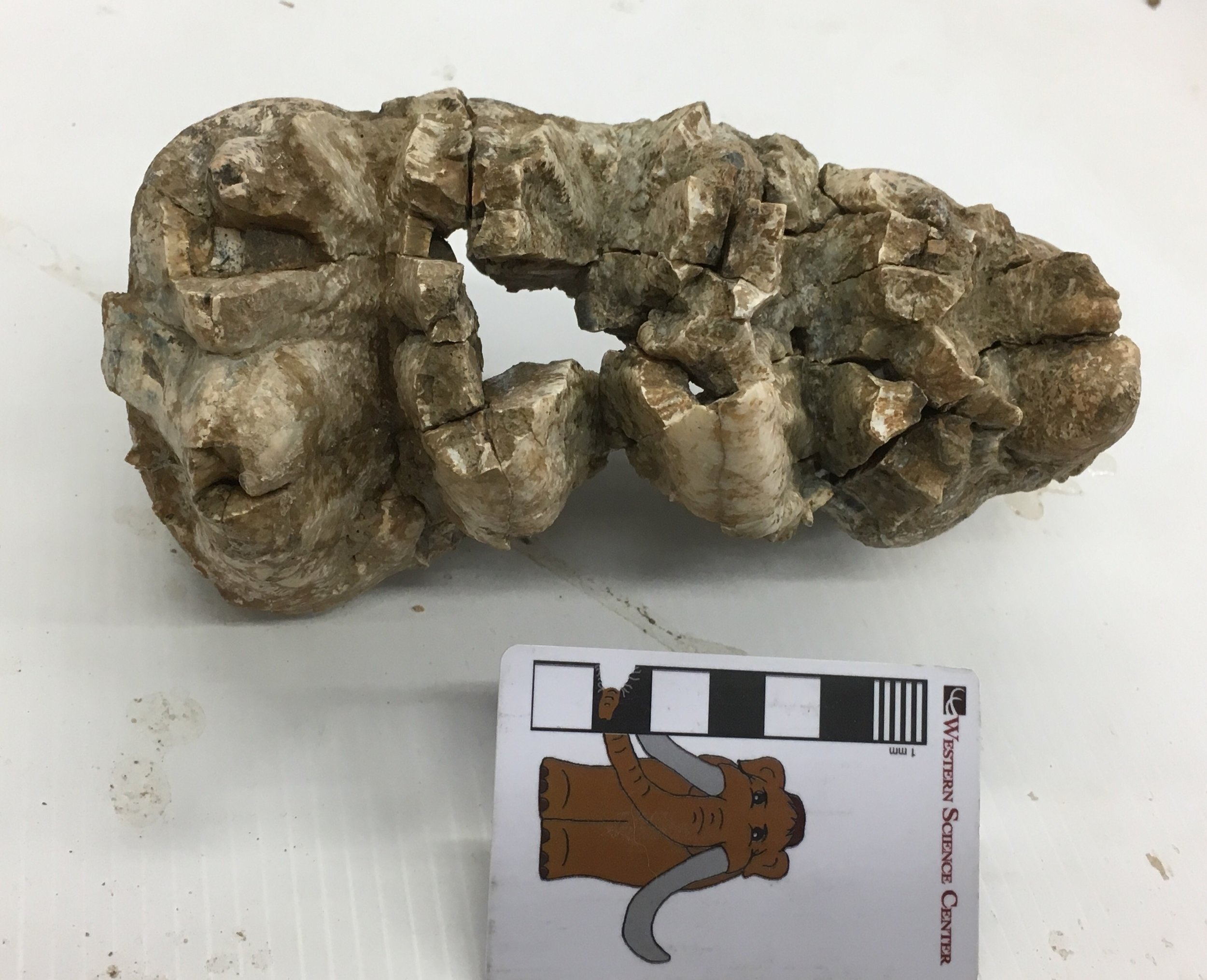 For the last few weeks, volunteer Joe Reavis has been diligently reconstructing a box of tooth fragments that came to the museum several years ago via a mitigation project in Murrieta, California. It quickly became apparent that the fragments were mastodon, and it seems they all come from a single tooth.The tooth is shown above in occlusal view, and the presence of four lophs show that it's a third molar. The angle of the lophs and comparison to other specimens in the WSC collection indicate that it's the upper left third molar.Here's the labial view:
For the last few weeks, volunteer Joe Reavis has been diligently reconstructing a box of tooth fragments that came to the museum several years ago via a mitigation project in Murrieta, California. It quickly became apparent that the fragments were mastodon, and it seems they all come from a single tooth.The tooth is shown above in occlusal view, and the presence of four lophs show that it's a third molar. The angle of the lophs and comparison to other specimens in the WSC collection indicate that it's the upper left third molar.Here's the labial view: And the lingual view:
And the lingual view: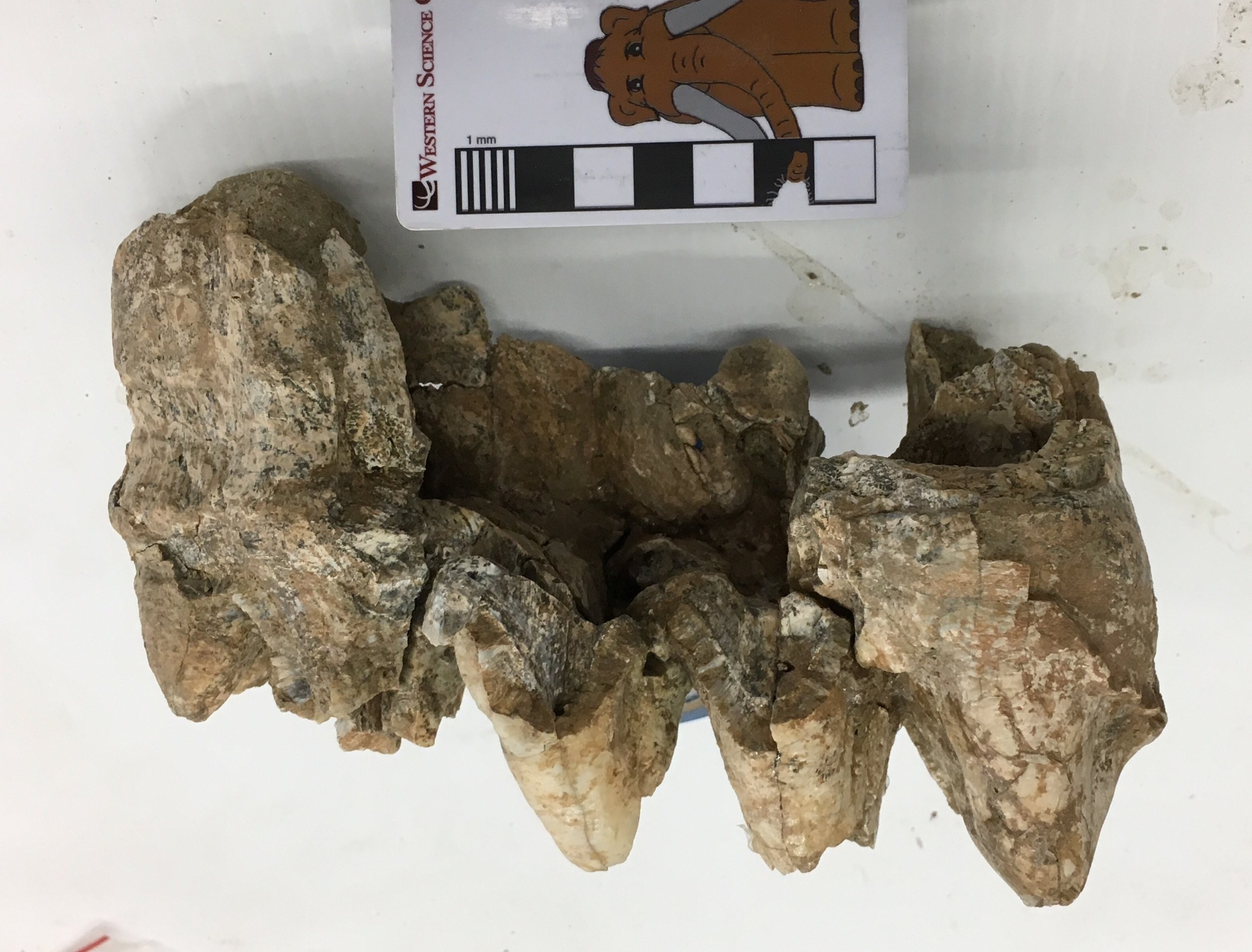 Looking past all the post-burial fracturing, this tooth shows no signs of any occlusal wear, and had probably not erupted. There is also enough preserved to get measurements for our "Mastodons of Unusual Size" project; the length:width ratio of this tooth is in the typical range for California specimens.The museum obtained several boxes of material from this site in Murrieta, but unfortunately it came with very little data or context. There is a fairly large amount of mastodon material included, including partial lower jaws with teeth and several limb elements, that are all consistent with a single individual. We're still in the process of preparing some of the other material.
Looking past all the post-burial fracturing, this tooth shows no signs of any occlusal wear, and had probably not erupted. There is also enough preserved to get measurements for our "Mastodons of Unusual Size" project; the length:width ratio of this tooth is in the typical range for California specimens.The museum obtained several boxes of material from this site in Murrieta, but unfortunately it came with very little data or context. There is a fairly large amount of mastodon material included, including partial lower jaws with teeth and several limb elements, that are all consistent with a single individual. We're still in the process of preparing some of the other material.
Fossil Friday - oreodont skull
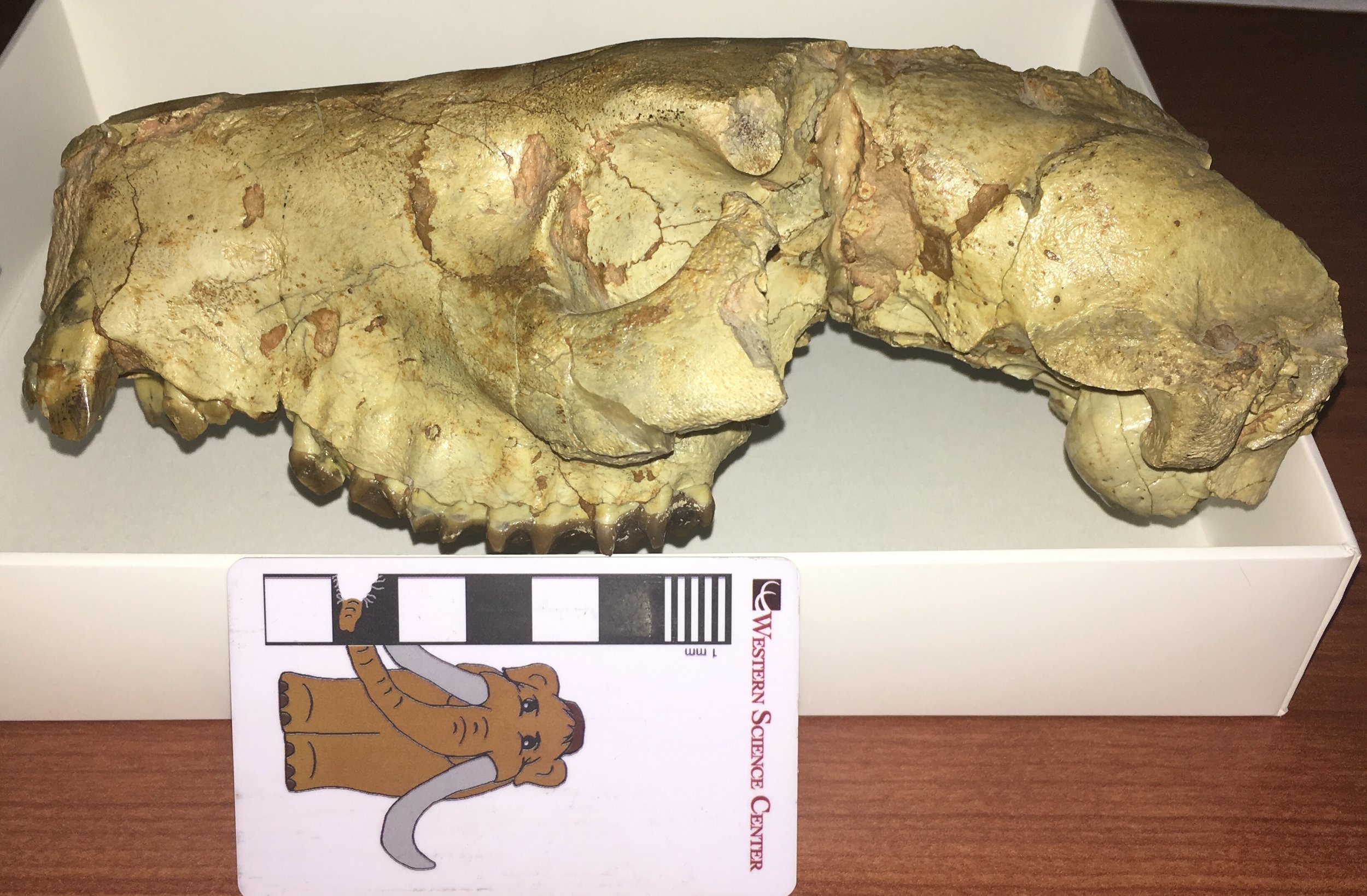 We're in the process of taking in a number of specimens collected by the late Harley Garbani, which are being donated to the museum by his wife Mary. The first item to come to us was a nicely preserved and prepared skull of an oreodont, the first in the WSC collection.Oreodonts are an extinct group of artiodactyls, generally thought to be distantly related to camels. They were very diverse and widespread in North America during the Oligocene and early Miocene, although they are most common in Oligocene deposits in the high plains and northwest, where thousands of specimens have been recovered.The skull collected by Harley came from the White River Group of South Dakota. It's missing much of the posteroventral area and the zygomatic arches, and some of the teeth are damaged, but otherwise it's in pretty good shape. At the top is a left lateral view, with anterior to the left. Below is the right side:
We're in the process of taking in a number of specimens collected by the late Harley Garbani, which are being donated to the museum by his wife Mary. The first item to come to us was a nicely preserved and prepared skull of an oreodont, the first in the WSC collection.Oreodonts are an extinct group of artiodactyls, generally thought to be distantly related to camels. They were very diverse and widespread in North America during the Oligocene and early Miocene, although they are most common in Oligocene deposits in the high plains and northwest, where thousands of specimens have been recovered.The skull collected by Harley came from the White River Group of South Dakota. It's missing much of the posteroventral area and the zygomatic arches, and some of the teeth are damaged, but otherwise it's in pretty good shape. At the top is a left lateral view, with anterior to the left. Below is the right side: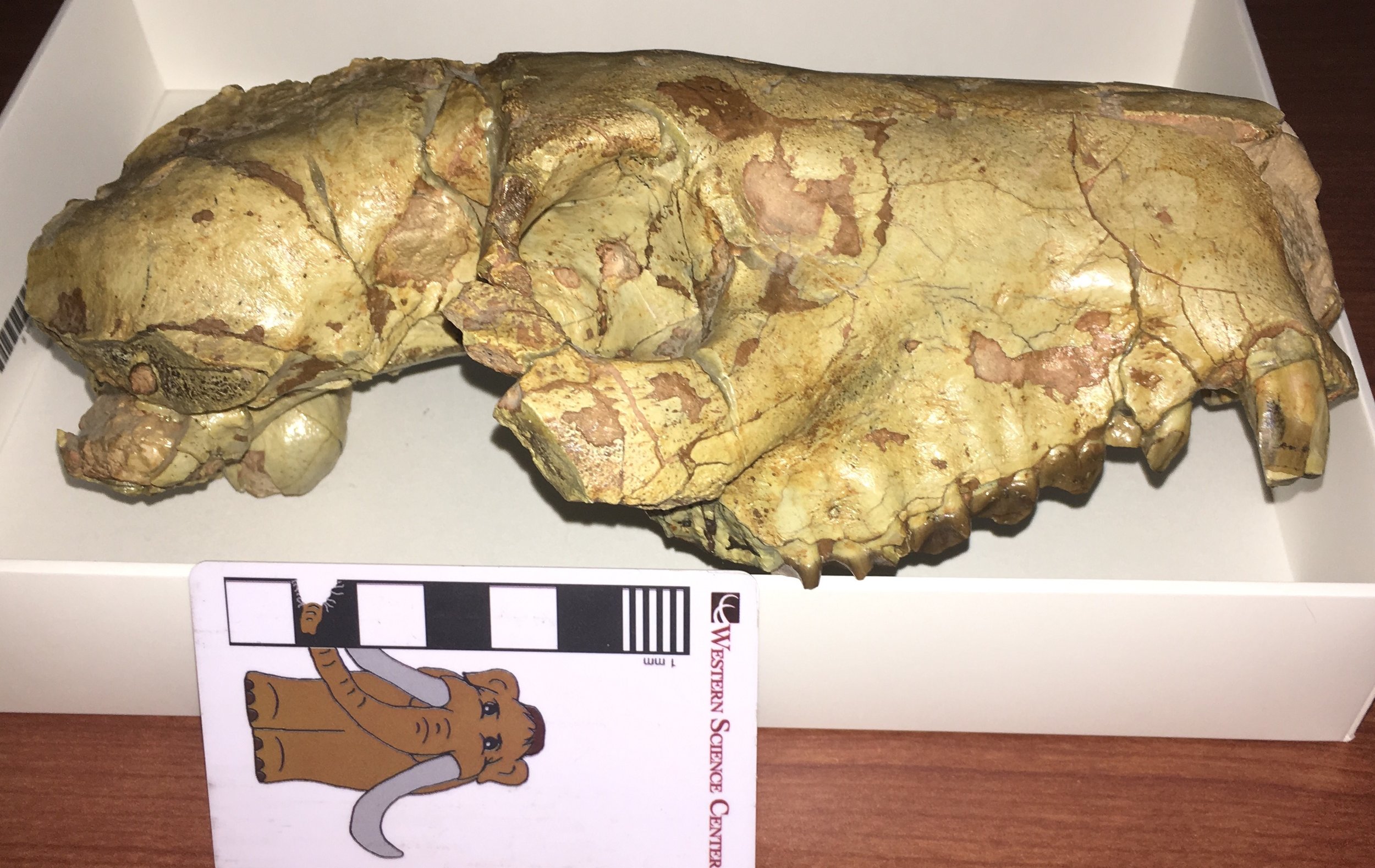 Dorsal view:
Dorsal view: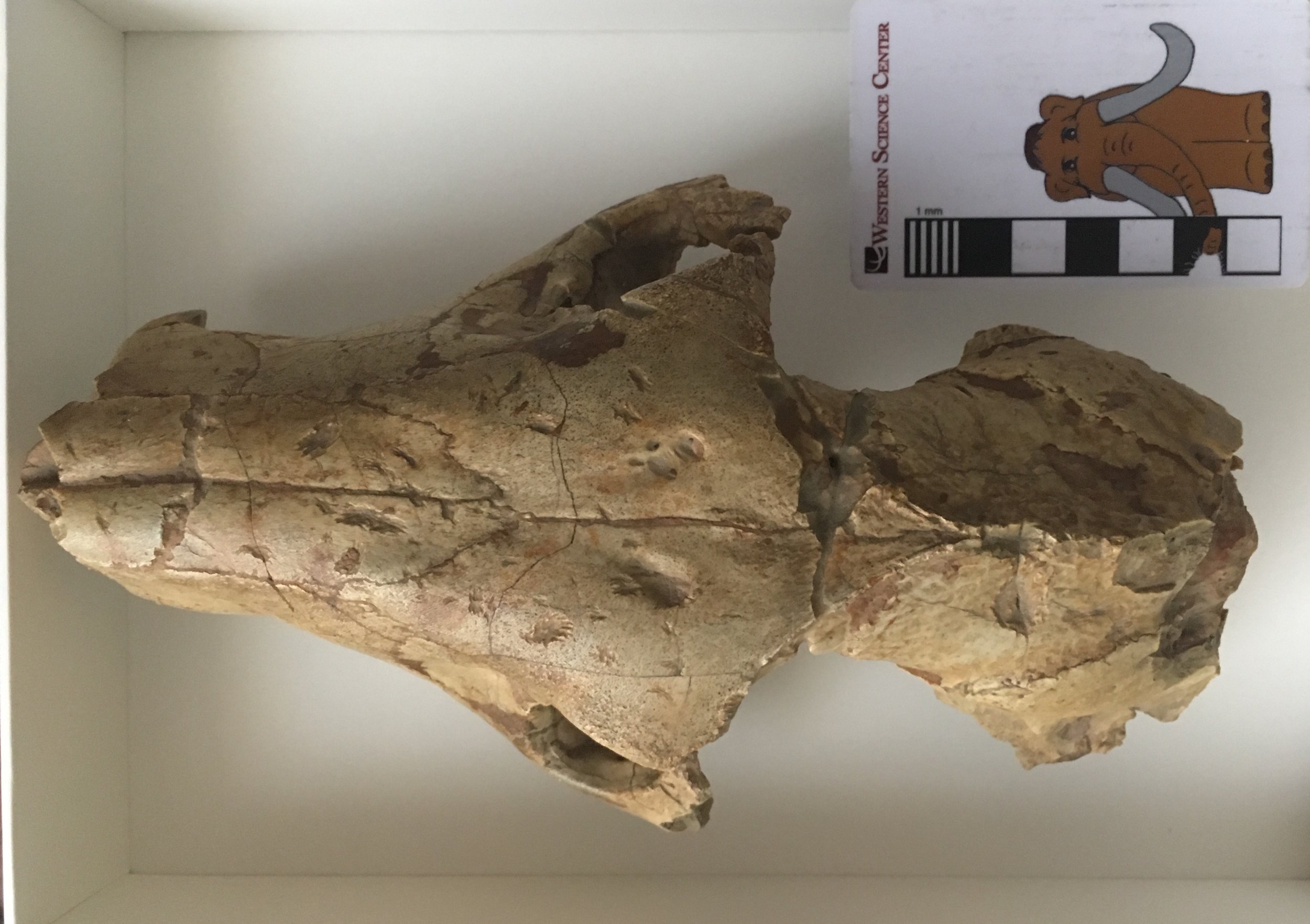 And ventral view:
And ventral view: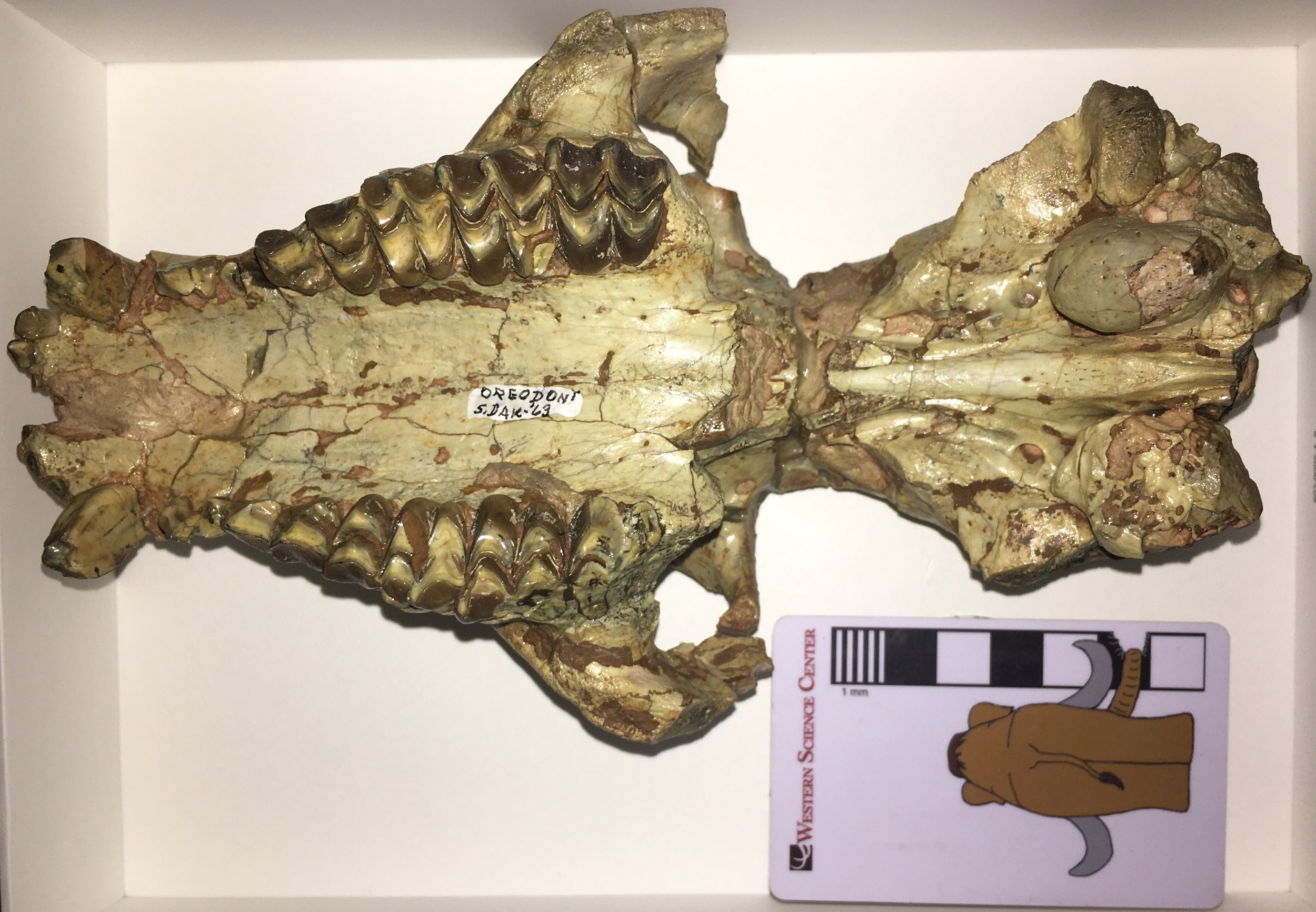 The front of the snout seems to end abruptly, as if part of it has been broken off, but the short, deep skull is actually normal in most oreodonts. If you look carefully at the teeth in ventral view, you can see that the incisors are preserved, confirming that the snout is complete. Based on the size and shape of the skull, I believe this specimen is from Merycoidodon culbertsoni, one of the most common oreodonts in the White River Group. Thousands of specimens have been collected, especially at Badlands National Park and the surrounding areas. The Museum of Geology at the South Dakota School of Mines has many beautiful examples of Merycoidodon on display, including this female that was pregnant with twin calves:
The front of the snout seems to end abruptly, as if part of it has been broken off, but the short, deep skull is actually normal in most oreodonts. If you look carefully at the teeth in ventral view, you can see that the incisors are preserved, confirming that the snout is complete. Based on the size and shape of the skull, I believe this specimen is from Merycoidodon culbertsoni, one of the most common oreodonts in the White River Group. Thousands of specimens have been collected, especially at Badlands National Park and the surrounding areas. The Museum of Geology at the South Dakota School of Mines has many beautiful examples of Merycoidodon on display, including this female that was pregnant with twin calves: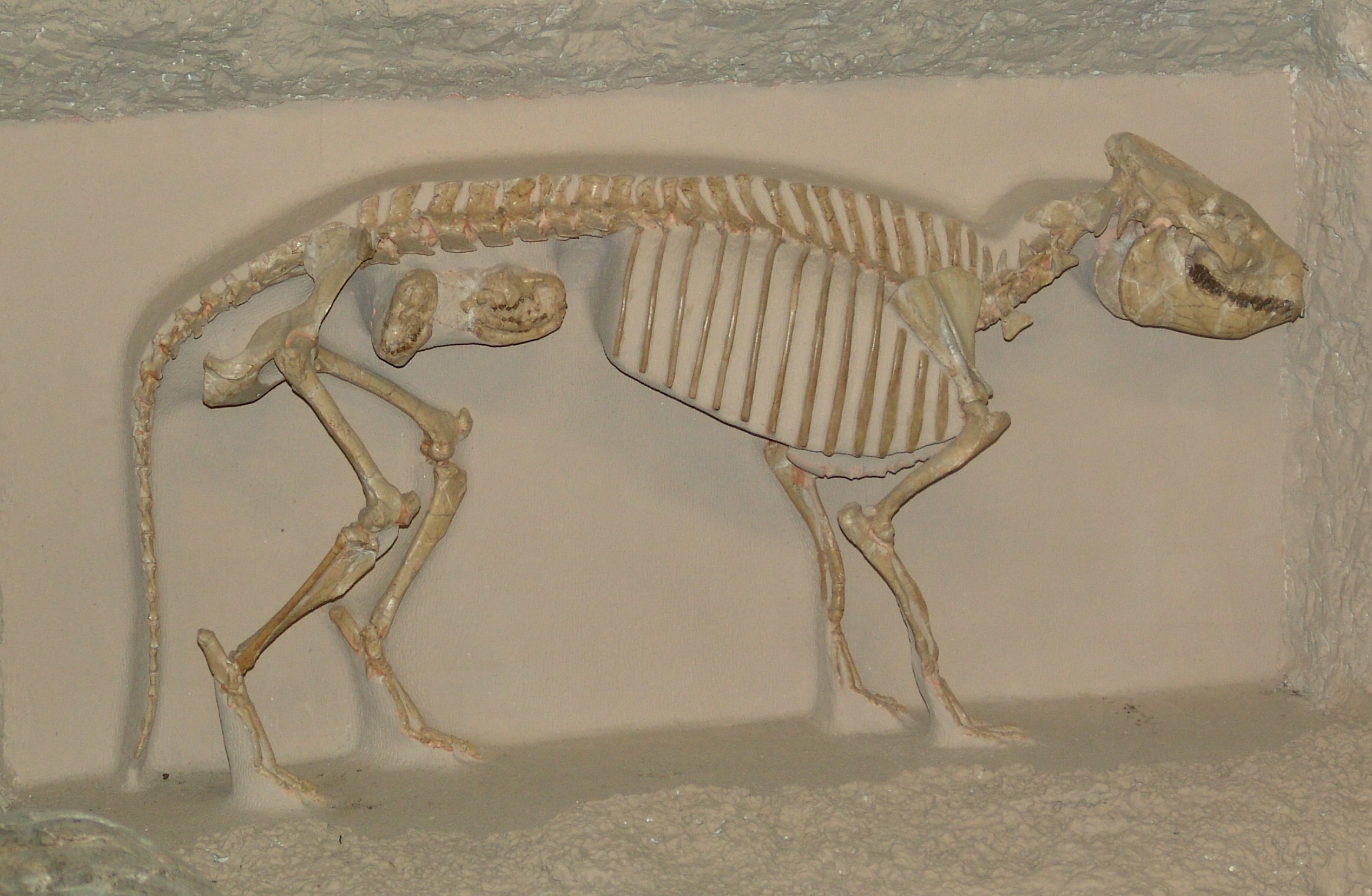 Oreodonts are often described as goat- or sheep-like, which is okay as far as it goes; Merycoidodon was about the side of a sheep. But oreodonts were most common before grasslands became widespread, so they were clearly not grazers in the same sense as sheep. This description also doesn't do justice to the diversity of oreodonts, which included forms that are nearly as large as a cow, as well as some that were probably more like tapirs and hippos in their habits.For more information on oreodonts and the environments they frequented, I encourage you to check out the virtual field trip on the Badlands National Park that Brett and I wrote a few years ago (link at the top right of the page; this requires iBooks on an iOS or MacOS device), or the Badlands National Park Twitter feed (@BadlandsNPS).
Oreodonts are often described as goat- or sheep-like, which is okay as far as it goes; Merycoidodon was about the side of a sheep. But oreodonts were most common before grasslands became widespread, so they were clearly not grazers in the same sense as sheep. This description also doesn't do justice to the diversity of oreodonts, which included forms that are nearly as large as a cow, as well as some that were probably more like tapirs and hippos in their habits.For more information on oreodonts and the environments they frequented, I encourage you to check out the virtual field trip on the Badlands National Park that Brett and I wrote a few years ago (link at the top right of the page; this requires iBooks on an iOS or MacOS device), or the Badlands National Park Twitter feed (@BadlandsNPS).
Fossil Friday - sloth thoracic vertebra
 Earlier this week, sloth expert Greg McDonald spent several days at the Western Science Center looking at ground sloth material in our collection. I spent that time peering over his shoulder and asking lots of questions. This made the work go more slowly, but it also greatly improved my understanding of ground sloths.At the top is an anterior view of a vertebra from Paramylodon harlani, the most common ground sloth from Diamond Valley Lake. Even though this is a damaged bone, it still shows some important features for understanding sloths.Sloths, along with anteaters and armadillos, are members of the Order Xenarthra, a group that is native to South America. While these animals may seem pretty disparate in their body plans, there are characters that they all share that reveal their relationship to one another. One of the most significant features is reflected in the name of the group; Xenarthra roughly means "alien joint".Most tetrapods have vertebrae that articulate with the vertebrae both ahead of and behind them in the column. Besides the main body of the vertebra (the centrum), there are usually a pair of articulation at the top of the neural canal called the zygapophyses. At the top front edge of the neural arch are the left and right prezygapophyses. The articular surfaces of the prezygapophyses face more-or-less dorsally, and articulate with the postzygapophyses, which are at the top back edge of the neural canal and face ventrally. Below is the dorsal view of a mastodon vertebra featured on Fossil Friday last April, with the prezygapophyses outlined in red (they would normally be symmetrical, but this specimen had been injured):
Earlier this week, sloth expert Greg McDonald spent several days at the Western Science Center looking at ground sloth material in our collection. I spent that time peering over his shoulder and asking lots of questions. This made the work go more slowly, but it also greatly improved my understanding of ground sloths.At the top is an anterior view of a vertebra from Paramylodon harlani, the most common ground sloth from Diamond Valley Lake. Even though this is a damaged bone, it still shows some important features for understanding sloths.Sloths, along with anteaters and armadillos, are members of the Order Xenarthra, a group that is native to South America. While these animals may seem pretty disparate in their body plans, there are characters that they all share that reveal their relationship to one another. One of the most significant features is reflected in the name of the group; Xenarthra roughly means "alien joint".Most tetrapods have vertebrae that articulate with the vertebrae both ahead of and behind them in the column. Besides the main body of the vertebra (the centrum), there are usually a pair of articulation at the top of the neural canal called the zygapophyses. At the top front edge of the neural arch are the left and right prezygapophyses. The articular surfaces of the prezygapophyses face more-or-less dorsally, and articulate with the postzygapophyses, which are at the top back edge of the neural canal and face ventrally. Below is the dorsal view of a mastodon vertebra featured on Fossil Friday last April, with the prezygapophyses outlined in red (they would normally be symmetrical, but this specimen had been injured): Below is an oblique view of the Paramylodon vertebra, looking down from in front (the centrum is partially visible at the bottom of the image):
Below is an oblique view of the Paramylodon vertebra, looking down from in front (the centrum is partially visible at the bottom of the image): Here is the same image, with the prezygapophyses outlined in blue:
Here is the same image, with the prezygapophyses outlined in blue: Notice the two articulations outlined in red? Those are the xenarthrous processes (the "alien joints"), which articulate with corresponding points on the posterior edge of the neural canal of the preceding vertebra. The xenarthrous processes are the key feature linking together the various members of the Xenarthra, and are not found in any other group of mammals.Thanks again to Greg McDonald for visiting WSC and giving us so much help with our sloth material.
Notice the two articulations outlined in red? Those are the xenarthrous processes (the "alien joints"), which articulate with corresponding points on the posterior edge of the neural canal of the preceding vertebra. The xenarthrous processes are the key feature linking together the various members of the Xenarthra, and are not found in any other group of mammals.Thanks again to Greg McDonald for visiting WSC and giving us so much help with our sloth material.
Fossil Friday - sloth dermal bones
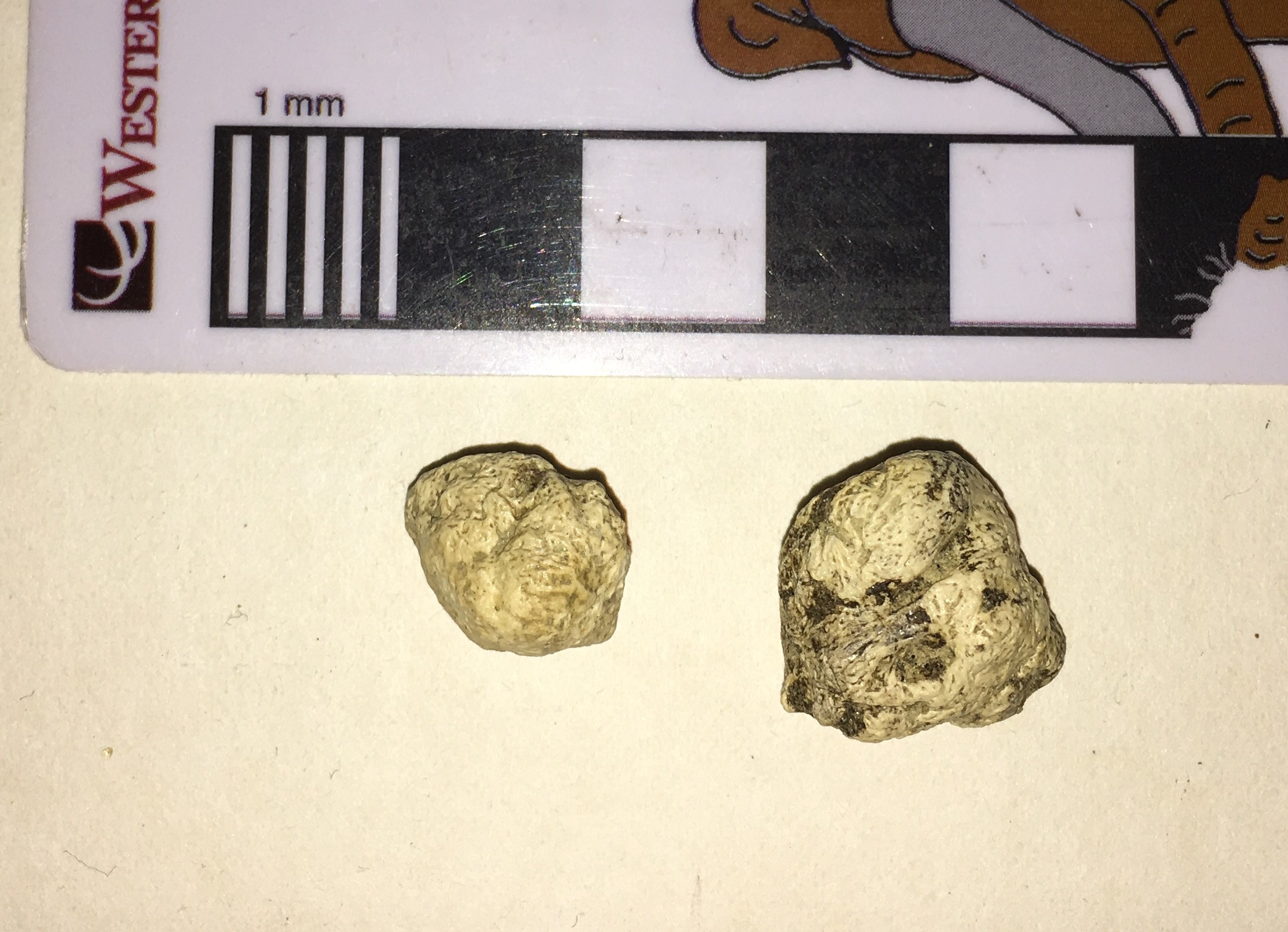 Next Tuesday evening, Greg McDonald is going to give a lecture at Western Science Center on fossil sloths, so for this week's Fossil Friday we have sloth bones!The tiny bones shown here are actually the most numerous sloth element found at Diamond Valley Lake. These are dermal ossicles, bony nodules embedded in the skin of certain species of ground sloths. Below is another view of the same two specimens:
Next Tuesday evening, Greg McDonald is going to give a lecture at Western Science Center on fossil sloths, so for this week's Fossil Friday we have sloth bones!The tiny bones shown here are actually the most numerous sloth element found at Diamond Valley Lake. These are dermal ossicles, bony nodules embedded in the skin of certain species of ground sloths. Below is another view of the same two specimens: Of the three sloth species found at Diamond Valley Lake, only one, Paramylodon harlani, is known to have had dermal ossicles. These two ossicles were found associated with a partial skeleton of Paramylodon from the East Dam (part of the jaw of this individual was featured in an earlier Fossil Friday). In fact, the larger ossicle had rolled into one of the empty tooth sockets in the lower jaw.The presence of dermal ossicles in some ground sloths is a bit surprising. The ossicles are generally assumed to provide armor protection, but they are tiny, and it's not clear how extensive they were. While several patches of preserved Paramylodon skin have been found with numerous embedded ossicles, we don't seem to find enough ossicles to cover the entire, or even most, of the body. It's also curious that most ground sloths seem to have gotten along perfectly well without dermal armor, including Megalonyx, which was close to the same size as Paramylodon, overlapped with it in time and space, and was even more widely ranging. Dermal armor is common in some other groups within the Xenarthra (the order that includes sloths), such as the armadillos and glyptodonts. So it's possible that the armor in Paramylodon is a relict, a holdover from some earlier sloth ancestor. But this would mean the earliest sloths should have had armor (as far as I know this is not the case), and that armor was subsequently lost in almost every sloth lineage except for a few species. So for now the origin and function of Paramylodon dermal ossicles remain a bit mysterious.
Of the three sloth species found at Diamond Valley Lake, only one, Paramylodon harlani, is known to have had dermal ossicles. These two ossicles were found associated with a partial skeleton of Paramylodon from the East Dam (part of the jaw of this individual was featured in an earlier Fossil Friday). In fact, the larger ossicle had rolled into one of the empty tooth sockets in the lower jaw.The presence of dermal ossicles in some ground sloths is a bit surprising. The ossicles are generally assumed to provide armor protection, but they are tiny, and it's not clear how extensive they were. While several patches of preserved Paramylodon skin have been found with numerous embedded ossicles, we don't seem to find enough ossicles to cover the entire, or even most, of the body. It's also curious that most ground sloths seem to have gotten along perfectly well without dermal armor, including Megalonyx, which was close to the same size as Paramylodon, overlapped with it in time and space, and was even more widely ranging. Dermal armor is common in some other groups within the Xenarthra (the order that includes sloths), such as the armadillos and glyptodonts. So it's possible that the armor in Paramylodon is a relict, a holdover from some earlier sloth ancestor. But this would mean the earliest sloths should have had armor (as far as I know this is not the case), and that armor was subsequently lost in almost every sloth lineage except for a few species. So for now the origin and function of Paramylodon dermal ossicles remain a bit mysterious.

